
The motoring magazine for SME fleets




RENAULT SCENIC


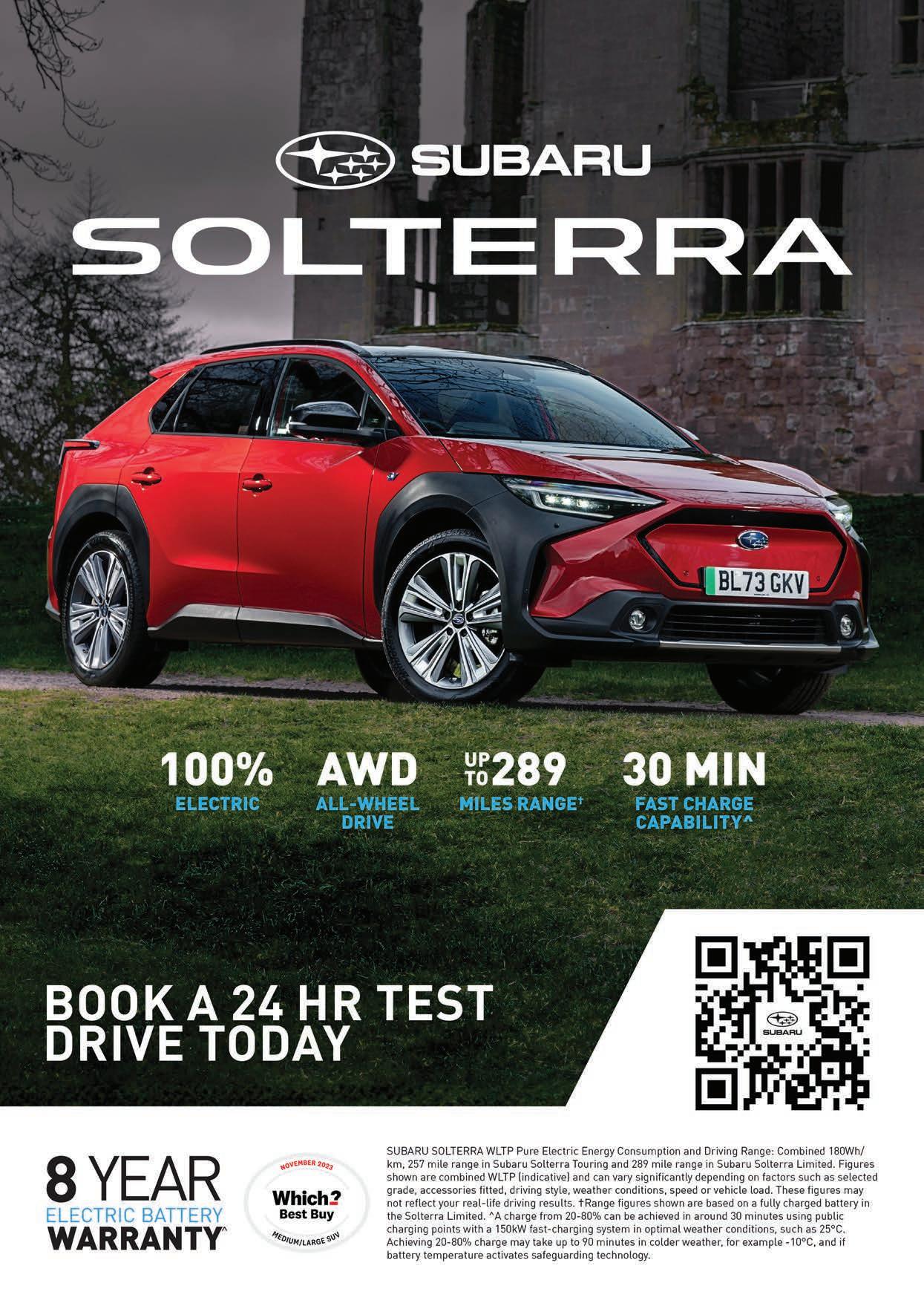
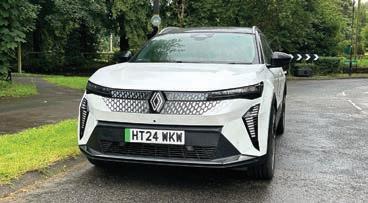
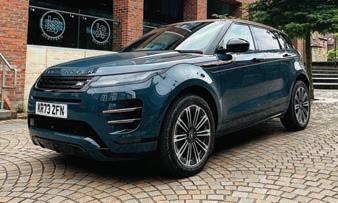
Our August print and digital issue is dominated by the launch of three new electric vans: our cover star, the MAXUS eDELIVER 5; the Mercedes-Benz eSprinter; and perhaps the most anticipated electric van yet, the all-new Ford E-Transit Custom.
We drove the eDELIVER 5 in Liverpool close to the brand’s UK HQ where it caused quite a stir on the streets. Not since we drove the Volkswagen ID.BUZZ Cargo in 2022 has an electric van garnered so much interest. What’s it like? Read our review inside.
When Mercedes-Benz launched the eSprinter Mk1 it only offered operators a 96-mile driving range, and it wasn’t ever going to offer mass appeal as a result. Fast-forward to 2024 and the brand has completely revamped it, with two big batteries offered and up to a 271-mile range. See how we got on when we spent a day in Benz’s largest van.
Ford’s Transit Custom has outsold almost everything else in the UK for the past couple of years, so the arrival of a new one is very big news indeed. Will the first electric version, which we tested on the streets of Frankfurt, tempt the reluctant van owner to go electric? Our thoughts are on page 50.
In other CV news, Volkswagen’s ID. BUZZ now comes with a longer wheel base and sportier powertrain, and we get to grips with Isuzu’s DL40 pick-up as it solidifies its

w: www.companycarandvan.co.uk Follow us at twitter.com/andrewmaxwalker and www.linkedin.com/in/companycarandvan
position as CC&V’s Pick-Up of the Year.
On the car front, trips to the Cotswolds saw us take in the all-new MINI Countryman Electric, which we found drives just as well as its petrol brethren. And Fiat has doubled its electric offering with the 600e, which in orange brightened up a dull day in Broadway.
Also on test this month are the Range Rover Evoque P300e, the all-electric Mazda MX-30 and the stunning BYD SEAL. We also take a look at Renault’s new Scenic E-Tech as it gathers even more awards, and the Jaguar I-PACE and Toyota C-HR are featured.
Away from reviews, CUPRA is setting record fleet sales and has appointed a new National Fleet Manager, Martin Gray; details inside. Subaru launched its electric Solterra in 2023 and has plans to electrify all of its models. We talk to Lorraine Bishton, Managing Director of Subaru (UK) to find out more.
Away from cars, the Juice Booster is a portable charging system that can help all EV drivers in their hour of need; we’ve a Q&A with Juice AG CEO, Christopher Erni. Plus we have contributions from CC&V regulars Rolec and Mobilize, CV sales specialists Vanaways and there’s news of a brand new Fiat and Abarth dealership in London.
Andrew Walker Editor and Publisher





Organisation: Collins Earthworks
Partners: Rolec EV and Monta
Industries: Mining, Earthworks
Location:
Matlock, Derbyshire
Rolec EV Products:
2 x Dual UltraCharge 240 units, with extended 7m cables
Benefits:
- Permanent installation of a reliable charging network for onsite HGVs with room to expand as the fleet grows
- Support towards the company’s environmental goals
Based in Ripley, Derbyshire, Collins Earthworks has been building a foundation in the civil and earthmoving sector for over 20 years.
Its broad repertoire of projects spanning two decades means it has developed an expansive fleet of heavy duty refuse and logistics vehicles. Recently the company made the decision to transition this fleet to more green energy sources.
To facilitate the switch, the team at Collins reached out to Rolec to aid in the creation, implementation and management of an EV charging network to support their growing needs, starting at their depot in Derbyshire.
Collins’ aim was to lay the groundwork for its initial phase of EV charging to start building up their network. More specifically, delivering on an efficient DC charging network to fully support its larger vehicles, eg, lorries and HGVs.
With the size and capacity of these vehicles in mind, accommodations would need to be made to make the charging experience more seamless, such as a larger electrical output via DC units and also a way to adapt the cables to be long enough to reach the typically higher charging ports.

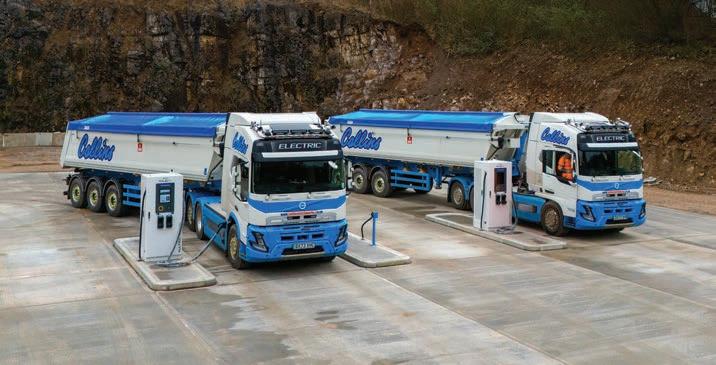
“Each unit has been fitted with bespoke extended 7m cables, allowing one side to be ducted underground. is design allows for the lorries to pull up easily in a forecourt-type layout, creating a more efficient and convenient charging system ...”
Alongside this, Collins wanted to ensure operational efficiencies of the site, including accurate vehicle downtime and quick turnaround times for charging sessions. It also wanted a competent back-office management system that would allow full visibility of vehicle charging status and efficient reporting systems.
As Collins endeavours to become a greener company, its commitments to sustainable investments and infrastructure are becoming increasingly more important. As its network of electric vehicles grows, there needs to be room for the network to grow alongside the business.
As part of the initial phase of chargepoint installation, Collins opted for two 240kW UltraCharge units, both fitted with dual CCS2 charging cables to provide four ultra-rapid chargepoints for use by their HGV fleet. In order to best meet the needs of these vehicles, each unit has been fitted with bespoke extended 7m cables, allowing one side to be ducted underground. is design allows for the lorries to pull up easily in a forecourt-type layout, creating a more efficient and convenient charging system for large commercial vehicles


Benefit anks to the sophisticated hardware provided by Rolec EV, Collins Earthworks is able to support the charging of its eHGV fleet seamlessly as they begin the adoption of clean energy vehicles. is is something that has also helped the company meet its environmental goals and desire to reduce its carbon output.
Additionally, this initial phase of chargepoint installation lays out the blueprint for the further introduction of zero emission vehicles as they embark on their transition away from fossil-fuel dependence.
Josh Holstead, Business Development Manager at Rolec EV and DC project lead, commented: “Supporting projects like this is always commendable and this initiative is no different; providing another brilliant example of Rolec’s capability to deliver purpose-built, turnkey solutions tailored to any environment or unique setup requirements.”
To find out more about the support Rolec offers to fleets, contact Josh Holstead at: josh@rolecserv.co.uk



ere’s a refreshing new look to the Renault’s Scenic E-Tech. Andrew Walker reports...
What is it ?
An electric five-door family hatchback with plenty of room on board for up to five adults. It comes with three trim levels –Techno, Esprit Alpine and Iconic – and two batteries, 62kWh and 87kWh, which are available on all three specs.
Techno with the 62kWh battery costs from £37,495, rising up to £45,495 for Iconic with the larger 87kWh battery.
All versions are very well appointed. Entrylevel Techno features 19” diamond cut alloys, front and rear LED lights, automatic air-con, heated front seats and steering wheel, wireless smartphone connectivity, a wireless charger, a rear camera and a 12” central touchscreen. Esprit Alpine adds 20” alloys, a fabric grey dash, a sports steering wheel, blue accents in the cabin, while the Iconic has bespoke 20” alloys, a panoramic sunroof, digital rear view camera with 360 degree view, a hands-free parking system, electrically adjustable memory driver’s seat with massage function and a Harman Kardon 12-speaker audio system.
Inside
It’s all very well put together, if a little safer than the offerings from Kia, Hyundai and BYD. e touchscreen leans slightly towards the driver which is good, especially if you need to get into a menu quickly. ankfully the climate controls are still physical switches, located underneath the screen. Elsewhere you can link into the adaptive cruise control and infotainment via the steering wheel toggles, the volume controls are still on the side of steering wheel stalk and the driving modes are altered via a circular MULTI SENSE button, but pretty everything else is adjusted via the touchscreen.
Range and performance.
e 60kWh model offers a range of 260 miles, while the larger 87kWh version will go to 379 miles on the WLTP combined cycle. If you opt for the smaller battery with 168bhp/280Nm on offer this has a top speed of 93mph and a 0-62mph time of 8.6 seconds. Choose the larger battery and you’ll add almost 50bhp with 300Nm which is good for a 7.6 second shunt to 62mph and a top speed of 105mph. Both are front-wheel drive with a front motor set-up which means, as with other EVs set up the same way, that acceleration is in the senisble bracket, though


mid-range is better, so motorway overtaking is very impressive.
Maximum DC charging is 150kW, so competitive. Renault claims a charging curve that averages 110kW to replenish 50kWh of your battery in just 30 minutes, enough for two hours of motorway driving. e standard onboard AC charger is 7kW, so slower charges at home means a 0-100% time of 8 hours on the 60kWh battery and 12 hours for the larger 87kWh version.
Driving modes and brake regeneration ere are four driving modes: Sport, Eco, Normal and ‘Perso’ which lets you choose your own combination of settings. ere are four levels of brake regeneration, which are selected using the paddles behind the steering wheel, a really simple and intuitive way to adjust these. ese range from none, through 2, 3 and 4 which offers one-pedal driving. All work well with no discernible transition from brakes to acceleration.
e steering is light so you can have a lot of fun on winding roads. Even on poor road surfaces the Scenic travels pretty well, with the suspension designed to handle the bumps, which it duly does impressively. You



also sit quite high up, so your command of the road ahead is very good. e regenerative set-up means you can almost one-pedal drive. e Scenic E-Tech doesn’t compromise on the French car comfort and soft ride we’ve come to expect. It’s perhaps not as much fun to drive as the Kia EV6 but it’s not been designed that way. On the motorway it’s quiet, comfortable and spacious. e on-board safety tech works well. Selecting cruise control is a simple affair and connecting wirelessly to Apple CarPlay was easy.
Practicality
It’s impressively roomy. A 545 litre boot is more good news with plenty of storage.
Pros
Two battery choices, a 379-mile range and a heat pump. All versions are incredibly well kitted out. Build quality is impressive. On board tech and safety works well, too.
Cons
e interior and exterior are a little safe. It doesn’t offer much acceleration excitement.
Renault has taken a pragmatic approach to the E-Tech. It’s very much a family EV that’s comfortable to be in and decent to drive. Well equipped, with 150kW charging speeds and all versions have a heat pump, an extra on many competitor’s cars. e cabin is also spacious and it’s well priced. e entry-level model is all you need to get a very nice car indeed.
CC&V RATING: N N N N N

Despite the global push towards electric vehicles (EVs) as a sustainable transportation solution, the UK is facing challenges in accelerating their adoption.
Frustratingly, many company and business drivers feel that there are still too many reasons not to drive electric, and these outweigh the positive reasons to switch.

One of the primary hurdles hindering EVs’ widespread adoption is the perception of insufficient charging infrastructure. However, significant strides have been made in expanding the network of charging stations. Zapmap recently reported that in the first four months of 2024, the rate of charge points being installed across the UK increased by almost 37% compared with the average across 2023. is means that there are now over 60,000 public charging stations across the UK’s road network.
But this isn’t the reason to adopt e-mobility. Driving electric is convenient and economical. Plugging in at home cannot be simpler and will provide sufficient charge for many business drivers, without the need to locate on street charging facilities. With the average
range of vehicles easily topping 300 miles, and the ability to charge overnight, vehicles can be ready for the journeys ahead without stopping en route.
Moreover, the cost of charging electric vehicles at home can be as little as 7p per kW on smart off-peak tariffs. is means that a vehicle with a 60kW battery can be fully charged for £4.20, and on a 300-mile range this is equivalent to just over 1p per mile!
Beyond immediate financial gains, electric vehicles also offer a long-term solution to mitigate fluctuating fuel prices. By reducing dependence on fossil fuels, companies can shield themselves from the volatility of the oil market, ensuring stable and predictable transportation costs. is stability enhances budget forecasting and financial planning for businesses, fostering a conducive environment for growth and investment. e maintenance requirements of electric vehicles are notably lower than their combustion engine counterparts. With fewer moving parts and simplified drivetrains, EVs experience reduced wear and tear, resulting in lower maintenance costs over the vehicle’s lifespan. Routine maintenance tasks such as
oil changes, spark plug replacements, and exhaust system repairs become obsolete, streamlining fleet management and minimising downtime for company operations.
For businesses, another compelling benefit of EVs for company car drivers is the accessibility to a private dedicated charging infrastructure. Workplace charging can benefit from the Government’s EV infrastructure grant, allowing businesses to get up to 75% off the cost of the work, up to a maximum of £30,000 and £350 off every charge point installed. ese workplace charging solutions enable company car drivers to easily recharge their vehicles during office hours, or while attending meetings and visiting clients.
In conclusion, electric mobility offers a multitude of benefits for company car drivers, which for many businesses can outweigh the negative reasons for electric. Aside from cost savings and convenience, driving electric provides environmental sustainability. is not only aligns with corporate values of efficiency and innovation but also positions businesses as leaders in the transition towards a cleaner and greener future.
By incorporating electric vehicles into fleets, companies can drive positive change while reaping tangible rewards for their bottom line and the planet alike.
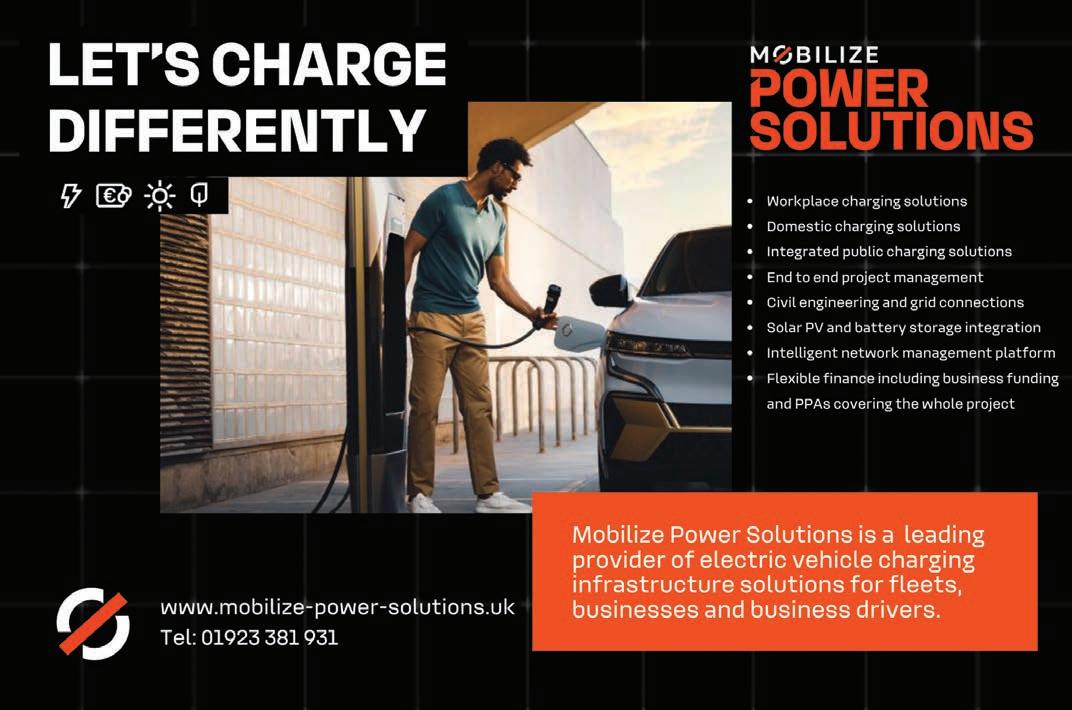
e MX-30 is currently Mazda’s first and only all-electric production vehicle. Company Car & Van had the opportunity to sample the latest Mazda recently and for an electric car, it drives and handles particularly well.
Powered by a relatively small 35.5kWh battery with a claimed range of 124 miles, it comes with AC charging up to 6.6Kw and DC rapid charging designed to meet 125A Combo Charging standards. e focus is clearly on driver appeal over extended range.
e MX-30 is more a small SUV than a supermini, which Mazda believes gives it greater appeal. It’s the same length and width as the CX-30, though taller.
Specification
ere are three specifications: Prime-Line Exclusive-Line and Makoto. Pricing starts from £27,995, and you can expect a high level of kit, with 18”alloys, powered driver’s seat, head-up display, heated front seats and an 8.8” TFT colour display, Apple CarPlay and Android Auto standard.
Inside it’s as classy as Mazdas have always been. From the floating central binnacle, which features the gear lever, infotainment wheel and electric handbrake, to the separate 7” climate control touchscreen, all is cleverly designed and beautifully finished. e use of environmentally-friendly materials, such as cork, vegan leather and recycled plastic bottles is also tastefully incorporated.
Up front, there’s two large door pockets, a sizeable glove box, two cup holders and an armrest with underneath storage. ere’s also a useful storage area underneath the floating centre binnacle. Rear passengers get small door pockets and rear seat nets.
Talking of which, the MX-30 may be an SUV in looks, but it doesn’t offer proper rear doors. Mazda have instead repeated the freestyle suicide doors. ese look fantastic and will work well with younger children, but adults will struggle to leave the rear with their dignity intact.
e rear passenger space is also tight and the black roof headlining on our test car made it feel a little claustrophobic.
Boot space is 341 - 366 litres with the rear seats in place, rising to 1,171 litres when folded down. ere’s no storage space for your charging cable though.
Good news: you get a free wall box home charger, while the car is equipped with both a Type 2 mode 2 charge cable for 3-pin plug charging and a Type 2 mode 3 charge cable


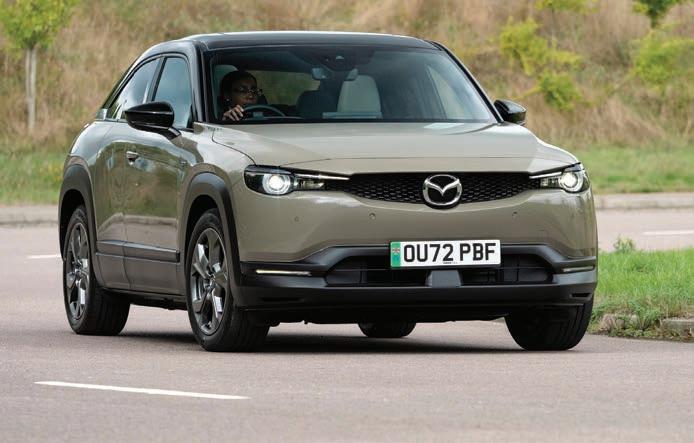



for AC charging via home or public charge points. Additionally, the DC socket allows for rapid charging up to 50Kw. In this charge mode 30 to 40 minutes can deliver up to 80% battery charge. Using a standard 7.2kWh home charger (http://www.rolecserv.com/ home-charging) will see a full charge in around five hours.
at small battery means the MX-30 is an awful lot more fun to drive than most EVs.
ere is also less regenerative braking than on many EVs, so there’s no real option for one-pedal driving to save battery range through brake regeneration. A positive from this is the MX-30 feels more rapid and much lighter on its feet than the competition.
It’s well poised and handles tight turns and corners with aplomb. Acceleration is adequate – there’s a total of 143bhp and 271Nm’s on offer – so 62mph is reached in 9.7 seconds, with a top speed of 87mph.
Motorway driving is another tick, with the quiet cabin and comfortable seats making a couple of 50 milers most enjoyable.
But what most impressed us was the ride. In all electric and plug-ins the addition of a heavy battery underneath the floor or rear quarters really alters the handling. Not so with the MX-30. e smaller, lighter battery is barely noticeable and there’s a lot of fun to

be had driving it. It also runs well over poor road services, doing this in almost complete silence and banishing the poor ride quality offered by almost every other electric car
BIK
anks to its zero emissions, you’ll benefit from 2% BIK. at alone is a compelling reason to choose one.
Pros
e smaller battery means the MX-30 reaches CO2 compatibility earlier in its life cycle than with rivals. It also makes the MX-30 a great car to drive, with excellent handling and near-perfect road manners, something incredibly rare in any EV. Build quality and design are five stars out of five, it really is that good. And price wise, it’s competitive, with excellent standard specification and safety features.
Cons at 124-mile range may not be enough for many fleet customers. e rear suicide doors limit appeal as a family SUV.
As a city electric car, the MX-30 is hard to fault. Drives and handles exceptionally well. From a driver’s perspective, one of the best electric cars we’ve driven and that would include the Jaguar I-PACE. Boot space is okay, but those suicide doors will put some off. Quality wise, superb. If you can live with the range, we’d highly recommend it.
CC&V RATING: N N N N

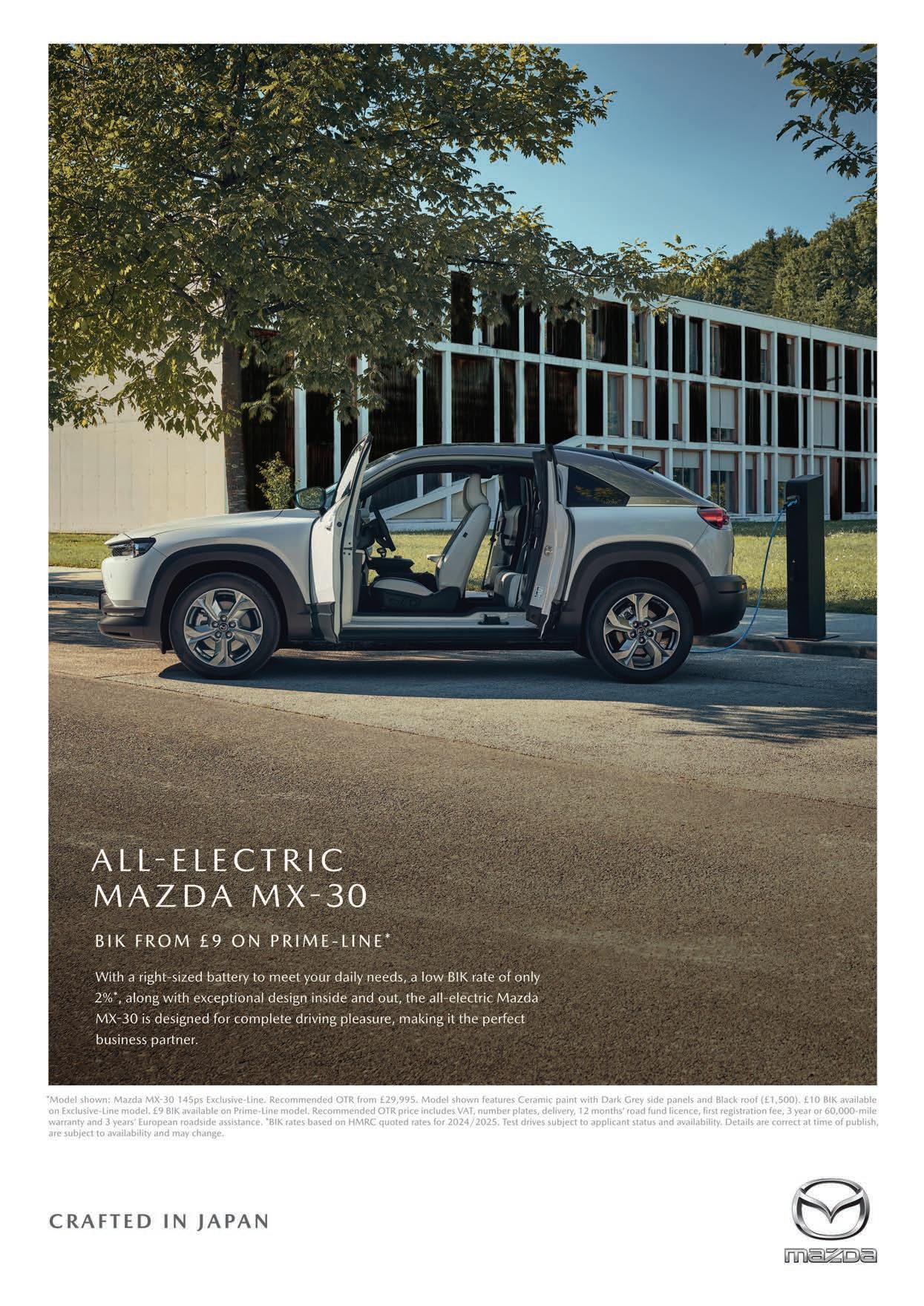
Range Rover has tweaked the Evoque plug-in to add an extra mile of electric range and tidy up the exterior and interior. We headed to the Cotswolds to see if these changes have made a very good car even better.
Engine
We’ll begin with the power train, because this IS the key to the PHEV’s low BIK and emissions. e plug-in features a threecylinder turbocharged petrol engine, plus an electric motor located in the rear axle. is gives the Evoque a pure electric range of 39 miles. While the 1.5 petrol engine offers a decent 200PS, it’s the extra 109PS courtesy of the 15kWh battery that really makes the difference, offering 540Nm of torque, enabling the 150kg heavier plug-in, to feel nimble. Indeed, it’s no slouch, hitting 60mph in just 6.1 seconds with a top speed of 132mph.
Model range and equipment
e plug-in Evoque is offered in four specs: S, R-Dynamic SE, R-Design Dynamic HSE and range-topping Autobiography. Start with the S. It features a rear camera, cruise control and speed limiter, Lane Keep Assist, front and rear parking aid, LED headlights, 18” alloys, leather seats, 12-way memory heated electric front driver seat, 10-way electric front passenger seat, wireless AppleCar Play and Android Auto, wireless charging, Pivi Pro with Connected Navigation and 11.4” touchscreen plus a 12-month Secure Tracker subscription.
As you can imagine the further up you go, the more you add: SE adds 19” alloys and a power tailgate. HSE is further enhanced with the addition of a fixed panoramic roof and 20” alloys. Range topping Autobiography includes 21” alloys, an ebony interior with extended Windsor leather and a tailgate spoiler.
Exterior and interior
e previous twin displays have been replaced by a single 11.4” screen which makes everything tidier. e loss of the lower screen means extra storage and room for a smartphone charging pad. Our Evoque featured the lovely looking ash veneer dashboard finish and the sliding panoramic that is standard on the Autobiography makes the cabin much brighter. Elsewhere, there’s a new stubby gear lever and some new trim and seat finishes including leather alternatives. A couple of changes we didn’t like included the loss of physical climate switches and volume controls, which are now adjusted via the touchscreen.



Interior space and practicality
e cabin is a joy to be in. ere’s some useful storage, with four storage bins, a cubby under the centre armrest, a rubberised tray on the centre console with two cup holders revealed underneath, decent door pockets and a glove box.
Rear space is a little tight and headroom is still a little compromised by the sloping roof and in our case the panoramic glass roof.
BIK and charging
With just 12% BIK on emissions of 33g/ km, the plug-in Evoque’s 15kWh battery takes approximately 2 hours 15 minutes to charge from empty on a standard home 7.2kWh charger, though a fast charger will do it in 30 minutes. One point: if the Evoque hit a 40-mile electric driving range it would reduce the BIK to 8%; a chance missed.
Economy
e city electric range is a claimed 46 miles the all-electric range 37.3 miles. Combined economy is as high as 190.9mpg but this is only achievable if you utilise the electric range as much as possible. In petrol mode alone, we only averaged 35.8mpg.
Drive in ‘EV’ mode and you stay on battery power alone, perfect for stop-start city traffic. On the touchscreen select ‘Save’ to utilise battery power in slow traffic, rather than it running out quickly if you drive on the motorway. It’s a useful feature.
Out and about
On the motorway there’s plenty of power and cruises beautifully. e cabin is very quiet, with little wind or road noise. On winding roads the small Evoque handled

exceptionally well and I really couldn’t fault it. It really is a lovely car to drive.
Pros
12% BIK, fabulous cabin, quiet and comfortable interior, very well equipped, brilliant off-road, premium image.
Cons
With our range-topping P300e Autobiography setting you back £60,385, the plug-in version makes most sense as a company car, leasing monthly. Rear seat space is tight. Misses out on 8% BIK by a whisper – and that’s a real shame.
Conclusion
For SME fleet customers who are lucky enough to be in the market for a premium SUV, we cannot recommend the plug-in Evoque highly enough.
e improvements further enhance the model range and we would put the Evoque at the top of the class for SUVs in its sector, until, or if, a pure EV Range Rover Evoque is offered with proper 4X4 capabilities. Until it does, the plug-in will do nicely, thank you very much.
CC&V VERDICT
e baby of the Range Rover bunch has a lot going for it. Cruises beautifully and the city electric range is perfect for short journeys in stop-start traffic.
CC&V RATING: N N N N N

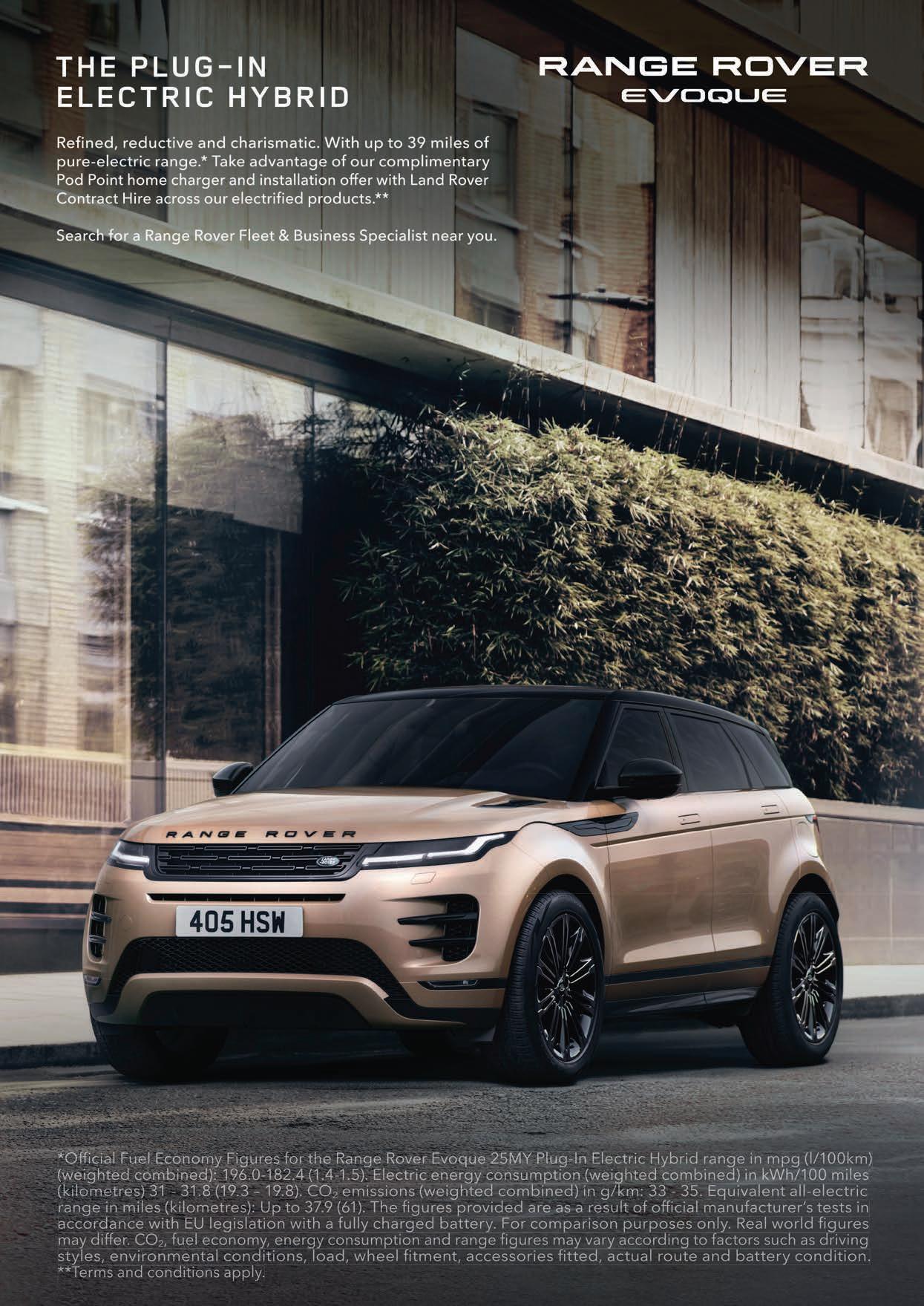


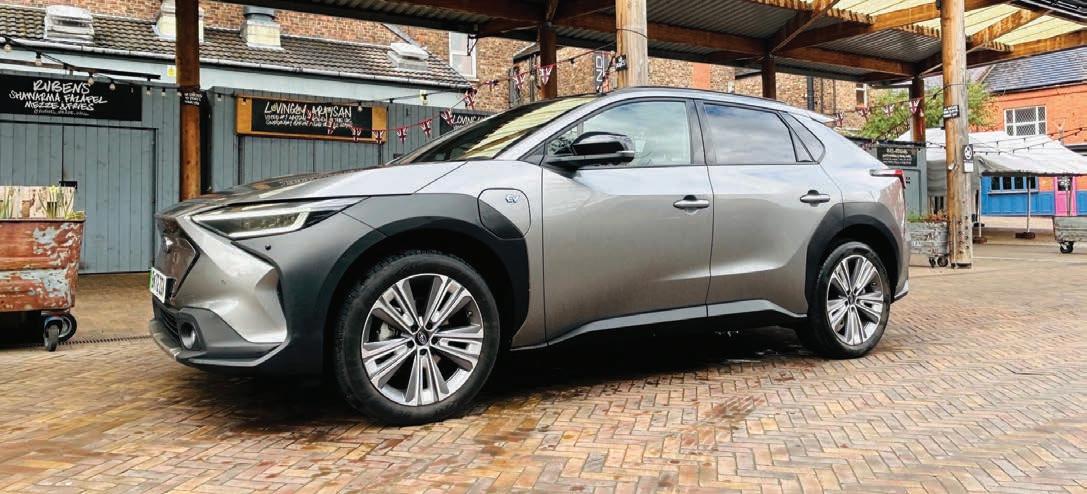
Subaru has an electric car and it’s called the Solterra – and that’s pretty much enough to get most people interested, says Andrew Walker
Developed in conjunction with Toyota, Subaru has used all of its all-wheel drive know-how on off-road settings to develop the Solterra, Toyota bZ4X and Lexus RZ 450e.
It’s a model that gives the brand a foothold in the electric car sector, and with a move by Subaru into business contract hire, an opportunity to target company car drivers. Subaru already has an extremely loyal customer base, so conquest sales will be the order of the day.
Model choice
Two options. e entry level is the Limited, from £52,995. It’s far from Limited, mind, with 18” alloys wheels, a 360-degree parking camera, a digital rear-view mirror, a heat pump, adaptive cruise control, a powered tailgate, heated front and rear seats and a heated steering. It’s also all-wheel drive, as is the Touring version, which adds a panoramic sunroof, wireless smartphone charging, a Harman Kardon sound system and larger 20” wheels to the list. In the fleet sector it’s the BCH price, currently £249 a month, that will be of most interest.
Exterior
e Solterra features plenty of angular edges. We particularly liked the front end
profile, the aggressive high wheel arches and the slim LED lights front and rear. e back has a rear roof spoiler that’s split with a small wing on each side for better aerodynamics. As with Toyota’s bZ4X, there’s no rear wiper.
Inside, apps and touchscreen
As with the exterior, the interior is quirky. For starters there isn’t a glove box and the dash features a sofa-like cloth finish. More interestingly, the TFT panel and information display are set back, so as with Peugeot’s i-Cockpit you have to look over the steering wheel to see the screen, which may be a problem for some. It’s also surrounded by what looks like a running machine set-up, with two grab handles, one on each side. It’s certainly different!
Both models feature a 12.3” touchscreen infotainment system, allowing access to connected Subaru’s Care Apps and control of
the car functions from a smartphone, including the ability to pre-heat the car, set charging schedules and view driving data. e graphics and touch reaction speed is excellent and one of the best we’ve come across. Below the touchscreen you get stand-alone climate controls.
Overall, the quality of the materials used in the cabin is high and more than a match for its competition. e cabin itself is light, roomy and airy, and there’s a generous 452-litre boot.
Engine, charging and range
e Solterra’s two electric motors produce 215bhp with 337Nm of torque and it will accelerate from 0-62mph in 6.9 seconds. e battery capacity is 71.4kWh with a DC charging rate of 150kW and AC of 7.0 kW. You also get two charging cables Type 2 and one with a domestic plug.


It will take nearly 12 hours to fully replenish the battery from a home charger but do it overnight and save money. An ultra-rapid charger will top up from 10-80% in take 28 minutes, but will cost north of 70p a kWh.
Subaru claims a range of 289 miles on a single charge in Limited-trim cars, while Touring-spec, the one we drove, is good for 257 miles. When our Solterra was fully charged in April, it showed a maximum range of 242 miles, so the Solterra isn’t too far off the benchmark from the likes of KIA’s EV6 and Hyundai’s IONIQ 5 and 6.
On the road
Start up and the Solterra is quiet and smooth from the get go. e steering is well weighted and you don’t notice the heavy battery, which is a very good thing. A 0-62mph time of 6.9 seconds is impressive but it actually feels quicker.
Despite its SUV pretensions, the Solterra actually has a low centre of gravity and coupled with excellent suspension makes for very enjoyable driving. ere’s very little in the way of crashing and vibrations even on bad road surfaces. You get capable handling coupled to a decent ride, with a bit of fun thrown in for good measure.
ere’s a regeneration feature to recharge the battery on the go. In the strongest setting, offers almost – but not quite – one-pedal driving.
Pros
Great looking and really good fun to drive. e cabin is brilliantly spacious and equipment levels are high. e inclusion of AWD will aid sales in certain sectors. For company car drivers its 2% BIK is a winner. On board 11kWh charging capability and a heat pump are also good news, as is the bargain bucket BCH rate currently being offered by Subaru.
Cons
It is expensive to buy outright, so Business Contract Hire is the order of the day for fleets. Watch out for a real-world range drop in winter.
Subaru is famous for its AWD expertise and super-fast models of old, but the new Solterra illustrates that it is well capable of making an impact in the EV world, too. Great quality – arguably the best Subaru yet –and great to drive, with excellent ride and handling. Off-road it will take you almost anywhere without breaking a sweat. Other electrics will go further, and winter range takes a hit, but despite this, Solterra is an excellent electric introduction.
CC&V RATING: N N N N
At the beginning of 2024, Lorraine Bishton was appointed Managing Director of Subaru (UK). Lorraine, who has been named three times in the biennial Autocar Top 100 British Women in the Global Car Industry, started her automotive career with Ford’s credit division.
She then moved to Jaguar Land Rover, holding senior positions in sales strategy and analysis before moving to McLaren Special Operations where she was Sales & Marketing Director.
Lorraine’s move to Subaru comes at a time when the brand is transitioning towards an electrified future, with its first EV, the Solterra, opening up opportunities with new company car customers.
CC&V recently spent a day with Subaru and put a few questions to Lorraine to find out more.
CC&V: Subaru isn’t perhaps the first name that springs to mind when SMEs are thinking of their new company car. Why should they now consider Subaru?
Lorraine Bishton: Subaru is a brand with a great legacy for safety, reliability, and all-wheel-drive expertise. While Subaru as a manufacturer has not been in the company car market for some time, this has all changed now with the all-electric Solterra. So if any purchasers are looking for those credentials in an all-electric package, then the Solterra could be the answer.
CC&V: With the brand’s AWD expertise, Subaru has always had a loyal following in the public sector, particularly for those whose role takes them off tarmac. Your Solterra EV is AWD: do you think you can keep these customers happy with an electric car?
LB: e Subaru Solterra embodies all the characteristics of the ICE-powered Subarus, with AWD, X-MODE off-road driving system, and assistance systems such as hill descent control, along with a class-leading ground clearance. It really is an all-electric vehicle that can go anywhere and can be a true workhorse, in the same way as the Forester, but with zero-tailpipe emissions.

CC&V: e Solterra is a collaboration with Toyota. As your brand electrifies its range, will there be any more joint electric ventures like this or will Subaru be making its own EVs?
LB: e Solterra is a result of the long-standing partnership with Toyota and there will be future vehicles for the brand as a result of the partnership. However,
Subaru is also committed to its own EV future and is investing $8billion in Subaru EV technology and new facilities.
CC&V: Talking of new EVs, can you tell us anything yet about what and when is coming next in the electric field from Subaru?
LB: Subaru is growing, not just in the UK, but worldwide. As such Subaru has announced the addition of three new EV products before the close of 2026, of which we are likely to see two in the UK.
A further expansion of the range will take place before the end of 2028, adding a significant number of models to the UK line-up.
CC&V: Finally, you’re just six months into your new role at Subaru. e brand doesn’t currently have a large sales presence in the UK. Where are you hoping UK Subaru sales will be in two years?
LB: Subaru UK is on an upward trajectory, with increases in sales in excess of the UK market growth.
We are building the brand with new product introductions, investment in EVs and we will scale the UK business appropriately.
Subaru has a target to increase sales across all European markets, so the UK is on a growth trajectory with significant percentage increases expected over the next few years.



CUPRA UK realised a huge 191% increase in its fleet sales last year. e rapid increase in fleet registrations for the challenger brand surpassed the industry’s overall performance – SMMT fleet registration figures showed a 38.7% increase in 2023.
CUPRA UK’s impressive fleet results were bolstered by the brand’s electrified offering, with CUPRA Born fleet registrations also tripling (200%) in 2023, and the CUPRA Formentor e-Hybrid variants delivering even more considerable results.
Offering sporty styling, usability, and competitive Total Cost of Ownership (TCO) values, CUPRA’s model range can cater to the specific needs of all businesses, whether they are looking to go electric, in the process of transitioning, or already fully electric.
Combine this with a national footprint of 120 service centres and 60 retailers (of which 12 are fleet specialists) and a suite of digital tools available to fleet decision makers, CUPRA UK rose to sixth place in the market for fleet sales.
“CUPRA UK delivered a massive increase in fleet registrations in 2023, growing on an already strong performance in 2022,” said Marcus Gossen, Director of SEAT and CUPRA UK. “When you consider that our fleet sales were zero as recently as 2019, to place sixth in the market is quite stunning.
“We have developed a fleet offering and network that genuinely appeals to businesses across the UK, and the future promises to be even more promising.
“In the next two years, we will be welcoming more electrified models to our range, starting with our first all-electric SUV


coupé CUPRA Tavascan later in 2024, as well as reinforcing the current fleet programme to continue our ambitious growth,” .
With robust residual values, competitive list prices, and generous specifications, CUPRA’s models have some of the most competitive TCO figures in their category.
When fleets choose the CUPRA Born for example, the combination of strong residual values and low running costs mean they will benefit from a competitive TCO of 39.5p/mile (3 years/60,000 miles) while retaining 42.5% of its value. Additionally, as a fully electric vehicle, it benefits from a BiK rating of 2% (2023/24), with P11D values starting from £35,030 (V1 58kWh e-Boost 230PS).
Similarly, the Formentor e-HYBRID also offers a competitive TCO due to its residual value of 38.6% and an efficient powertrain that returns a combined mpg of up to 235.4

miles (WLTP) (1.4-litre DSG-auto 204PS).
Both models have received industry recognition with CUPRA Born most recently winning the Best Small Electric Car to Drive at the What Car? Awards 2024 – the second year in a row it has won this award. Following this success, CUPRA will be extending its electrified offering in 2024 and 2025 with the upcoming launch of the new CUPRA Tavascan all-electric SUV coupé, followed by the CUPRA Terramar performance plug-in hybrid, and the CUPRA Raval urban electric car.
Pricing for the fully electric CUPRA Born now starts at £35,085 (V1 58kWh 230PS).
Also on offer for eligible fleet customers is the option of a complimentary wall box or CUPRA charging voucher for orders placed and delivered 03/04-31/12/244.
• See https://www.cupraofficial.co.uk/fleet/ cupra-fleet/cupra-range.
Martin Gray has been appointed National Fleet Manager for SEAT and CUPRA UK.
Martin, who joined the Volkswagen Group in 2011, has been in the automotive industry for 30 years, with 18 years of fleet experience. e role of National Fleet Manager is Martin’s fourth role with the Group, following a period of seven years as Contract Hire & Leasing Manager for the SEAT and CUPRA brands.
Martin will now oversee a team of seven fleet experts and aims to deliver a brand and product offering for businesses that continues to challenge the norm in the UK fleet industry.
Martin said: “I am delighted to be leading a fleet team that has already accomplished so much. My priority is to continue achieving successful results for SEAT, as well as grow awareness of the CUPRA brand within our existing customer base, leasing company partners and fleet retailer specialists.
“I am particularly excited to be introducing the 100% electric CUPRA Tavascan and the PHEV CUPRA Terramar
models within the next year, as they will be a gamechanger for our fleet customers.”
Marcus Gossen, Director of SEAT and CUPRA UK, said: “Martin has great experience within Volkswagen Group and has played a fundamental role in our fleet department for a number of years. We are delighted to see him step into the role of National Fleet Manager to lead a strong team that is achieving brilliant results.”
Martin’s appointment comes as CUPRA UK’s fleet sales triple with 191% increase over the course of 2023. e rapid increase for the challenger brand surpassed the industry’s overall performance – SMMT fleet registration figures showed a 38.7% increase in 20231.
Martin Gray

Looking to make a more environmentally friendly investment for your next vehicle purchase? Vanaways is here to help you and your businesses drive into a more sustainable future.
e EV movement
e growing interest in electric vehicles has been spurred on by businesses looking to invest in ‘greener’ vehicle options to align with environmental governance and global carbon neutral movements.
As a result, we are now seeing more manufacturers expanding their EV range to accommodate for this shift in the market. anks to various Government funding incentives and tax benefits, businesses can take advantage of the significant savings on offer through financial support with outright purchase, coupled with reduced maintenance and operational costs which is a huge attraction point for many business owners who are considering the accessibility to transition to electric.
Technology and range – a thing of the past EV technology has come a long way since Robert Anderson’s primary cell powered carriage in 1832, and more recently over the past five years.

While the distance you can travel in an electric vehicle is notably less in comparison to alternative fuel counterparts, the available range is slowly increasing as technology continues to advance.
e lack of range and subsequent journey efficiency was once a concern for many road users. However, the charging infrastructure in the UK has substantially improved in the last year, with a 43% increase in the number of public charging devices and a 45% increase in the number of rapid charging devices. In total there are now 64,775 electric vehicle charging points across the UK, in 33,829 charging locations.
Doing your bit for the planet Emission-based contributions from combustion engines in domestic travel
account for 29% of the UK’s greenhouse gas emissions. e zero exhaust emissions from electric vehicles not only negate this impact, but it also offers eco-centric benefits to align with your corporate social responsibility in reducing the carbon footprint of your business.
While the production and manufacturing of electric vehicles are more energy-intensive than those of combustion engines, the emissions created by this process are offset throughout the vehicle’s operational life.
Vanaways – Your electric van expert e choice between diesel and electric vans has become a critical decision for commercial businesses. Both options offer unique advantages and challenges, making it important to weigh the factors that impact leasing vans for business.
At Vanaways, we specialise in assisting businesses looking to make the transition to electric vans tailored to their specific needs, ensuring a hassle-free transition to sustainable transportation solutions.
Our expertise and personalised approach help businesses navigate the complexities of electric vehicle adoption, assessing whether it’s right for your business needs, enabling you to reap the benefits of lower operating costs and reduced environmental impact.


e EV charging industry is innovating at pace. A newcomer to the UK market is Juice Technology, and its CEO, Christoph Erni, took time out to tell Company Car & Van a little more about how this company is looking to revolutionise electric vehicle charging
CC&V: Plenty of company car drivers have switched to electric and have a home 7.4kWh charger to power their car. What can the Juice Booster do to help those who have taken the EV plunge but can’t fit a charger at home?
Christoph Erni: If you take a portable charger like the Juice Booster 2 with you, there’s no need to install a wall box. It is more than just a charger. e portable solution provides safe charging wherever there is an available socket, allowing EV drivers to charge anywhere in the world using any domestic or industrial socket.
Whether it’s a friend’s house, your workplace or any other destination, you just need the right adapter plug to charge your car anywhere at any time.
at’s where the Juice Booster 2 comes in, making recharging an EV as easy as charging your smartphone and putting an end to range anxiety for those worried about running out of juice on long journeys. It doesn’t matter if there’s a public charging point nearby, or whether it’s working or not. When you run out of power, you have your own charger to hand. In addition to this, as well as being a portable charger, it can also be used as a wall box at home thanks to the wall mount.
CC&V: Many of our readers run electric vans and this sector will be growing massively over the next few years. Where do you see the Juice Booster fitting in for those who charge their vehicles at depots or workspaces during the day, and which type of business will most benefit from using it?
Christoph Erni: e portable charger is flexible and easy to use, adapting to different types of vehicles and situations where it is not always possible to rely on public charging points. is makes it suitable for any type of business, from the construction industry – which needs to manage the charging process for vehicles involved in temporary construction sites that are open on different
sites at the same time – to delivery companies that need to use electric trucks to enter city centres for last mile delivery.
e big advantage of the Juice Booster 2 over other portable solutions is that it has extension cables. ese are proprietary and therefore just as safe against polarity reversal as the safety adapter plugs for power connections. ey are available in 5m or 10m lengths.
With this universal solution, you can easily extend the Juice Booster 2 by a further 5m, 10m or 15m without a lot of tangled cables. is allows you to bridge up to 25 metres to the nearest power connection. You can easily charge the delivery van at the loading bay while loading or unloading goods. e cables are of high quality and robust, and the Booster itself is even safe to drive over.
CC&V: A number of electric vehicles offer Vehicle to Load capability (V2L) [a bidirectional power feature on EVs that lets you use the large battery in an electric vehicle to power or charge something else], and on a recent trip to Germany with Ford we saw this in action with van users powering tools from their battery, enabling them to work cable free.

Does the Juice Booster have a part to play here as well?
Christoph Erni: Just recently, at Power2Drive in Munich, Juice Technology presented the bidirectional Booster. is prototype is based on the proven Juice Booster, which is already successfully used in numerous vehicle models.
In addition to adapter plugs for outlets, the bidirectional version also allows you to connect novel socket adapters. It requires no dongles or additional equipment and is not complicated to install. For V2L (Vehicle-toLoad), for example, a specially designed adapter plug with a socket is simply plugged into the Juice Connector on the Juice Booster and thus serves as an ordinary household socket. is makes it easy to power
appliances such as a coffee machine or a drill from the car.
Our goal is to combine all unidirectional and bidirectional charging scenarios with a single device – and one that can still be used as a mobile charging station on over 35 different power outlets worldwide.
CC&V: We’ve spoken at length about the Juice Booster, but does Juice Technology have any other products coming?
Christoph Erni: e Juice Ultra 2 battery is one. When setting up their infrastructure, companies are often faced with the challenge of covering all charging scenarios as efficiently and future-proof as possible. Usually, the ideal solution is to expand the infrastructure with AC charging stations,
integrated load management and a central control system.
But sometimes things need to move faster, for example when business customers stop by, or when sales representatives only have time for a quick stop to recharge before heading off to their next appointment, or even when a van is being loaded and unloaded and the lunch break is being used to prepare for the next delivery. In all these cases, DC stations would be required, but they are often costly and time-consuming to install.
at’s why Juice Technology launched the Juice Ultra 2 battery. It’s a fast-charging station that combines the benefits of direct current charging with the flexibility and ease of an AC charger. It is a DC charger with a large integrated battery storage system that sets new standards in electric vehicle charging: fast DC charging without the need for a power increase or earthworks, high charging performance with low grid connection power and even solar-powered charging.
is new charging station enables fast vehicle charging via direct connection to a conventional industrial socket (eg, CEE32, but preferably CEE63 or CEE125). e result is significant time and cost savings.

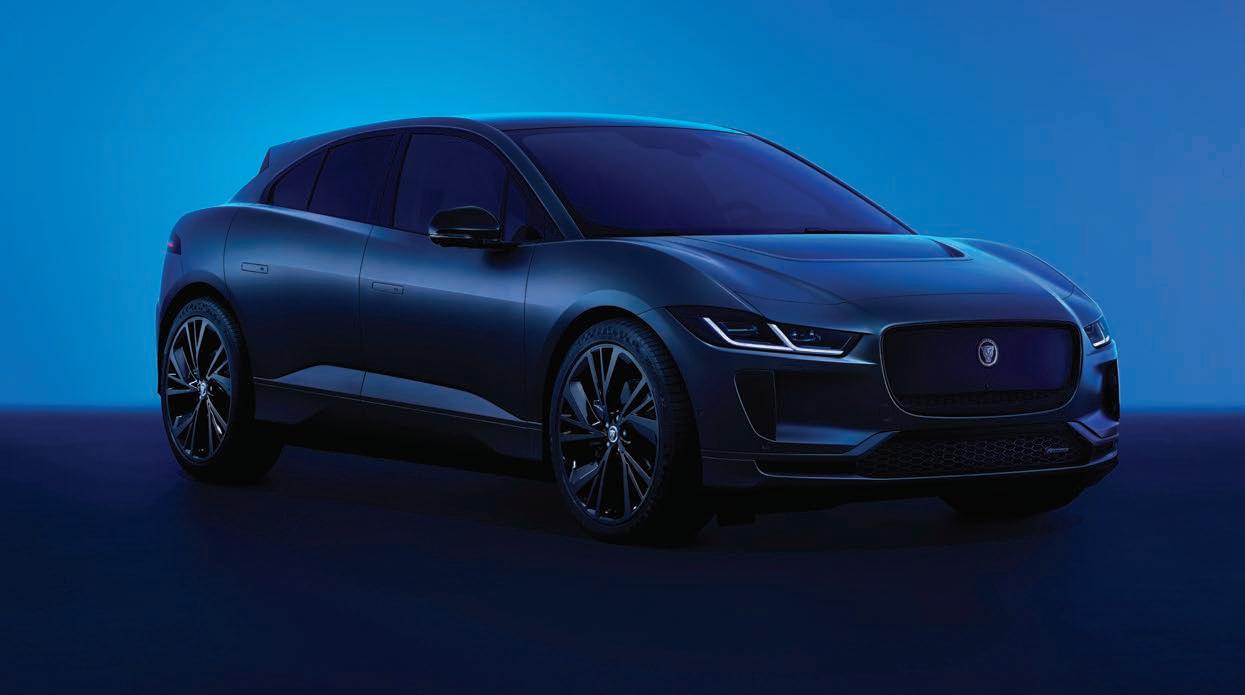
THE JAGUAR I-PACE has been subtly enhanced, with a more distinctive design, richer specifications, new R-Dynamic models and striking satin paints in a choice of two metallic colours.
It delivers an unrivalled balance of performance, refinement, agility and technology with impressive real-world range and day-to-day usability – up to 292 miles (WLTP) from a full charge and up to 33 miles of range/ hour (WLTP) from an 11kW AC wall box and three-phase electricity supply
A new flagship 400 SPORT variant is introduced, enhancing I-PACE’s sleek visual appeal and fitted as standard with a range of advanced features, including slimline heated and cooled Ebony Windsor leather seats.
e I-PACE’s cab-forward profile, short overhangs and taut, muscular haunches are instantly recognisable and set it apart from other all-electric SUVs. is award-winning design has now evolved, with subtle, carefully considered enhancements which deliver even greater presence.
e front ‘shield’ grille now has a smooth form, in striking Atlas Grey. e front bumper finishers, lower door finishers and rear diffuser are now body-colour instead of Gloss Black. is treatment serves to simplify and refine the design while taking away visual mass.
Models including the 400 SPORT feature a discrete tailgate spoiler, subtly reflecting I-PACE’s performance potential and dynamic character.
All wheels offered on I-PACE R-Dynamic models as standard equipment are now diamond-turned, while a newly introduced striking 22-inch Style 5069 wheel now has a Satin Grey finish to complement its carbon fibre inserts. All 22-inch wheels may be specified with self-sealing All-Season tyres. Perfectly complementing these updates is
the exterior Black Pack. Now standard on all models from the R-Dynamic SE Black and above, the Gloss Black finish is applied to the grille surround, window surrounds, door mirror caps and rear badges. ere’s also the option of a contrast panoramic roof.
e UK-only 400 SPORT now sits at the top of the I-PACE range, adding additional styling and convenience features above and beyond the R-Dynamic HSE Black, including a bootlid spoiler and adaptive air suspension as well as 22-inch Style 5056 Gloss Black alloy wheels. It also features I-PACE’s most advanced slimline performance seats, with fine Windsor leather and 14-way adjustable heated and cooled driver memory seats.
Performance and dynamics
I-PACE delivers a true Jaguar driving experience. With light, compact and efficient electric motors integrated into the front and rear axles, I-PACE can accelerate from 0-60mph in just 4.5 seconds and up to maximum speed of 124mph.
Delivering comfort and agility without compromise is what has always made Jaguar unique. I-PACE’s advanced double wishbone front- and Integral Link rear suspension are fundamental to this dynamic capability, together with the low centre of gravity and light, stiff aluminium body structure. Air suspension with Adaptive Dynamics electronically-controlled damping enhances ride and handling still further. is Electronic Air Suspension with Adaptive Dynamics is fitted as standard to the 400 SPORT, along with Adaptive Surface Response for the ultimate dynamic driving experience.
I-PACE’s 90kWh Lithium-ion battery delivers a range of up to 292mile range (WLTP)3. When charging using the fast-
growing network of public chargers, a 100kW DC charger can add up to 78 miles of range (WLTP) in just 15 minutes. Customers with three-phase electricity and an 11kW home wall box can add up to 33 miles of range (WLTP) per hour; a full charge takes only 8.6 hours. Customers in single-phase markets using 7kW wall boxes can achieve up to 22 miles of charge per hour and a full charge in 12.75 hours. To maximise the benefits of off-peak energy there’s the Low Cost Hours Only feature: just set start and stop times that match your tariff – typically overnight – and charging will only take place during that period.
Customers can also set charging to stop when the battery reaches a specific level – 80 per cent for example. is is especially useful when using public chargers because you can add only the range you need to reach your destination.
I-PACE drivers have also access to Jaguar Charging a growing Pan-European public charging network that brings them easy access to a network of over 400,000 charging points stretching across 27 countries and over 700 separate charging point providers including the newly added Ubitricity as part of a growing network –which will see even more network operators being added in 2023.
Infotainment and connectivity
Inside I-PACE’s spacious interior there’s all the technology you need to make every journey more enjoyable. Every model has the fast, intuitive Pivi Pro infotainment system, offering seamless connectively through wireless Apple CarPlay®, Wireless Android Auto™, integrated Alexa voice control, Spotify, and what3words navigation. Pivi Pro is always up to date thanks to softwareover-the-air updates.
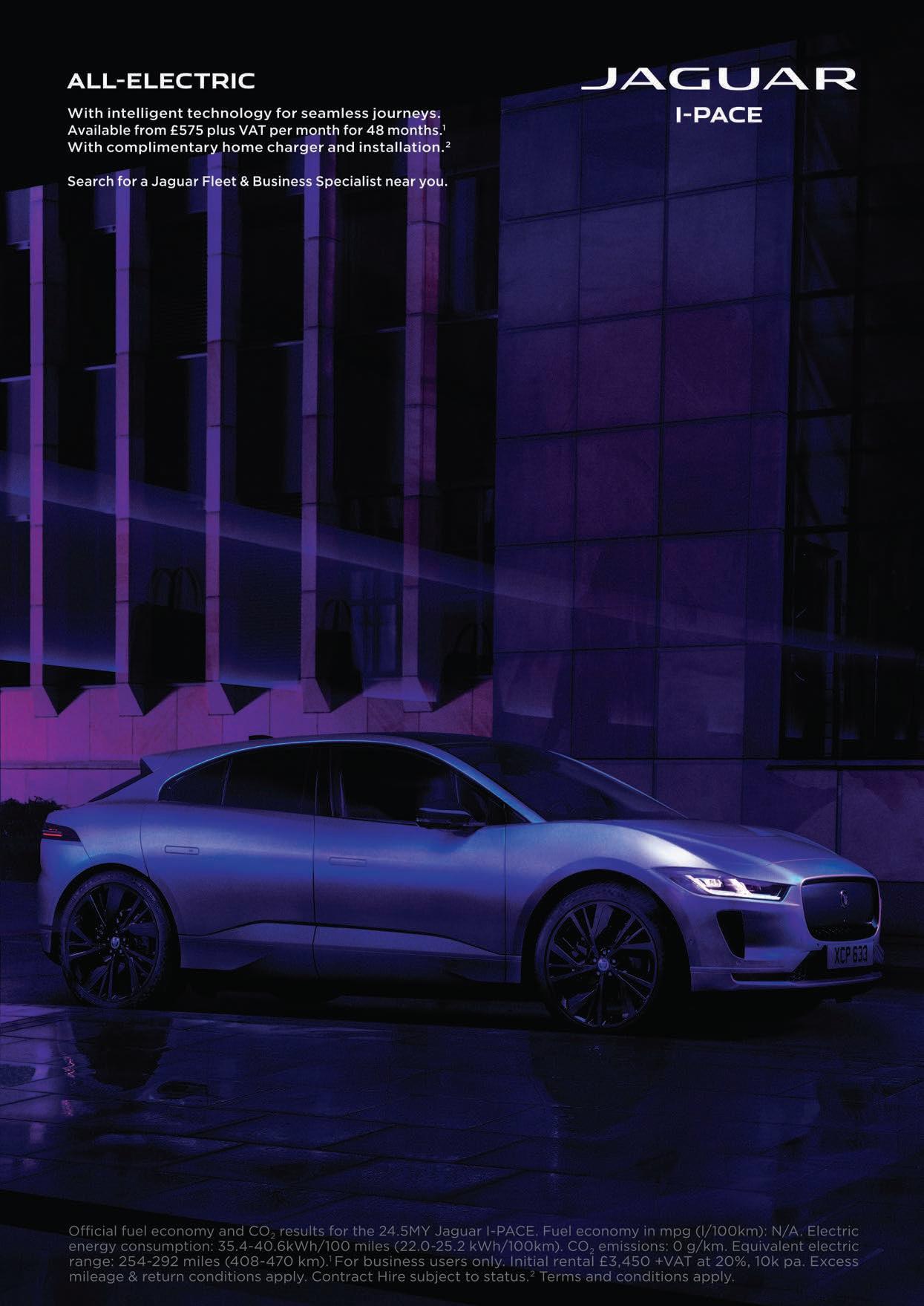
La Dolce Vita was Fiat’s thinking behind its new electric car, the 600e. Literally translated as ‘the sweet life’, the essence of La Dolce Vita means to enjoy the small things, taking time to pause and appreciate everyday moments and generally to live life to the full. e Fiat Cinquecento has been achieving this for over 60 years and the original Fiat 600 actually predates it by a couple of years. e latest 600 is an evolution of Italian design, with the electric version the first to arrive in the UK. We spent an enjoyable day in the Cotswolds putting it through its paces.
Tell me more
is is a more family-friendly model for people who can’t get enough of the 500 but need more practicalty. Just two models, RED and La Prima, offered with an electric powertrain. A hybrid will be with us soon. For size, think 500e but with four doors.
Engine, range and performance
e 600e utilises the latest Stellantis 54kWh battery which comes with a claimed electric range of 254 miles WLTP for urban and motorway driving or a maximum 372 miles around town. ere’s 156hp on offer with 260Nm’s of torque, a 0.62mph time of 9 seconds and a top speed of 93mph.
Charging
e Fiat 600e is equipped with a 100kW DC charger so can charge the battery from 20% to 80% in 27 minutes. ere’s also an 11kW onboard AC charger and a Mode 3 cable, which delivers a full charge in 5 hours 45 minutes. As ever get a home charger and yourself on an EV electricity tariff to utilise the cheaper rates on offer overnight.
Driving modes and regeneration
ree driving modes: Eco, Normal and Sport, plus a B regeneration option in the gearbox. ere’s no gear lever as such, rather four buttons located in the central dash for P, R, N and D/B, the regeneration setting. ere’s not a lot of soft touch surfaces on offer, but rather sensible, tough looking finishes. e magnetic cubby cover and steering wheel are soft touch though.
Inside
e dashboard and console set up mirrors that of the Jeep Avenger. So beneath the
touchscreen, you get a large cubby hole with magnetic cover, the electric handbrake and Drive Mode switch and a square of four buttons under the touchscreen. ese are for the home screen, the car functions, hazards and to lock/unlock the 600e with a line of short cut buttons underneath.
ere’s a 10” touchscreen, which feels a good size. A tick for the easy Apple CarPlay wireless connection to our i-Phone. Another tick for separate climate controls and separate volume control. e graphics are clear and response times pretty good.
At a metre longer than the 500e there’s definitely more space. Front seat passengers have good head and leg room and there is good storage on offer. e rear is comfortable but a bit of a squeeze for three.
We tried out the three main driving modes and while Eco would be our de facto choice to conserve your battery range, Sport does loosen the shackles and you can get a bit of fun from the car. In ‘D’ mode the 600e tootles along quite happily. When you add the ‘B ‘regeneration to the equation, there’s a bit of brake pull as you slow down, but it’s not very strong and definitely doesn’t equate to one pedal driving.
Our drive over rural roads exhibited the 600e’s excellent road manners; it is very sure-footed. It’s very quiet, with little wind or road noise getting in. e quiet motor adds to the calm.
On a dual carriageway, cruise control and Normal driving mode offer a compromise between Eco and Sport with plenty of power available. Sport mode does increase the revs, but drains the battery faster.
After a 50-mile sojourn our battery range had fallen by 56 miles, about what you’d expect in late February on a mix of A and B roads plus some urban crawl and a couple of single lane farm tracks. Company car tax is 2% BIK, means that a 20% taxpayer would pay just £11 per month, making the electric 600 a company car owners’ dream.
Pros
2% BIK, cute looks, good cabin space and clever Italian design. Add in the on board 11kW charger so your 600e will charge to full in under six hours and you have a seriously attractive proposition. And Fiat are also offering a £3,000 e-grant off the new 600e.
Cons
Not as spacious as some competitors. Internal finishes are a little disappointing.
e electric 600 is a nailed-on company car proposition because plenty will have looked at a 500e but thought it too small. e Italian touches are also most welcome.
CC&V RATING: N N N N N


A new Fiat and Abarth showroom has opened at the flagship Stellantis &You dealership in Chiswick, West London
e new showroom marks FIAT’s return to the capital and comes at an exciting time for the Italian brand, following the recent launch of the New Fiat 600 and Abarth 500e, which now sit alongside the iconic Fiat 500 in the marque’s ever-expanding range.
e opening is part of an ambitious expansion plan for the FIAT retail network, with the total number of dealerships scheduled to increase from 76 to 100 during 2024.
e Chiswick site was originally upgraded with a £14.5 million investment in 2020 but will now give Londoners a chance to access and enjoy a taste of La Dolce Vita.
Located on the ground floor of the building, the space will feature the brand’s new Dolce Vita corporate identity. e complete FIAT and Abarth range will be available at the dealership for customers to discover and test drive, including the Fiat 500 and new Fiat 600, with both models available in electric or hybrid format, and the Abarth 500e.
e state-of-the-art facilities also include
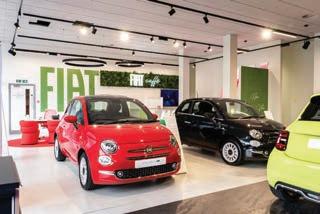
ample EV charging points for customers, a 12-bay workshop and two MOT bays. Further support is provided by an off-site parts hub, fleet and business centre, and additional aftersales facilities at close-by Brentford. Stellantis &You West London is fully operational and ready to welcome future FIAT and Abarth customers now.
It will be a key location for FIAT and Abarth in London, supporting private, business and Motability customers.
Richard Garbutt, Stellantis &You UK Chief Executive commented: “FIAT presents a fantastic opportunity for Stellantis &You in London, and I’m excited to see the new showroom launch. We all love to see new products coming to market, and in Fiat 600e,
we have a model with style and flair to suit Londoners sitting alongside a range of electric and hybrid options. With five brands available at West London, we can offer our customers so much choice.”
Damien Dally, Managing Director Fiat and Abarth said: “ e return to London for FIAT and Abarth is an important development for our brand, and the Chiswick location is perfect for us. Our product range is growing quickly, with Fiat 600 and Abarth 500e now sitting alongside the ever-popular Fiat 500 in our growing product line-up.
“With the Abarth 600e coming later in the year and more exciting product news only a few months away, this is the perfect time for the brand to be back in the capital. As always with FIAT, we try to add a touch of Dolce Vita to people’s lives and look forward to doing just that at West London.”
Stellantis &You UK recently celebrated the first anniversary of its name change and currently holds 57 new vehicle franchise locations in the UK, having recently acquired a Vauxhall site in Selly Oak, Birmingham, and opened a multi-million-pound six-brand showroom in Bristol at the start of July.
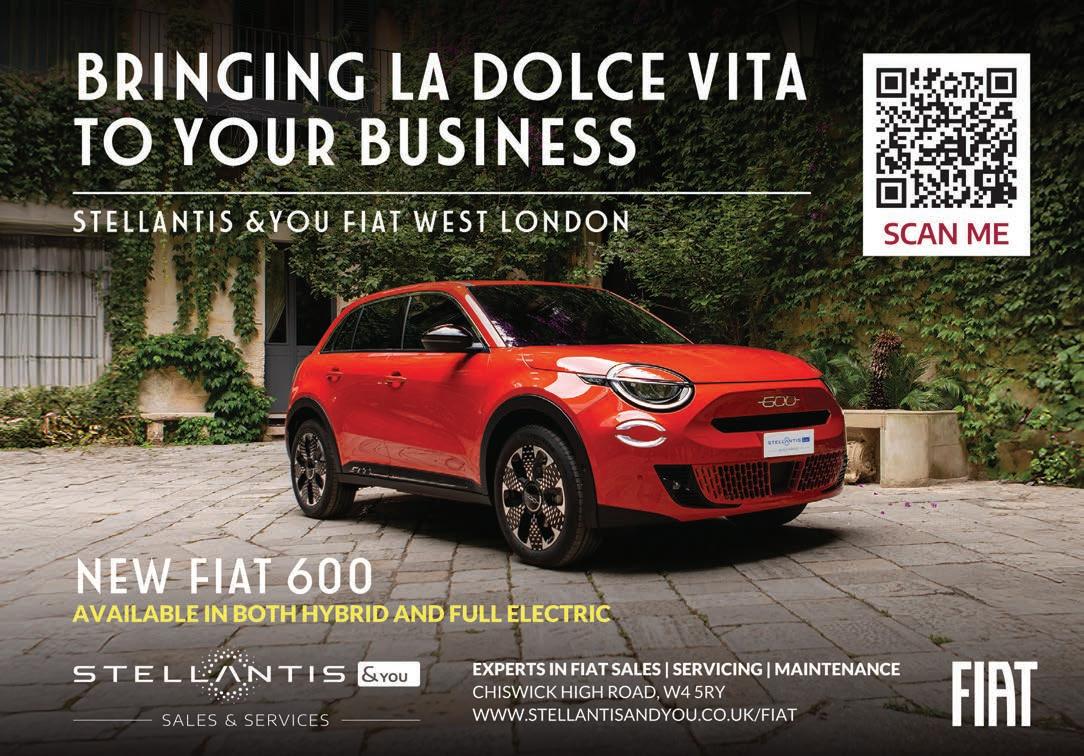
MINI recently launched an electric version of its largest model the Countryman, and Company Car & Van had an opportunity to drive it recently.
ere are two electric trims. Countryman E has a single 140kW motor on the front axle, producing up to 201bhp with a 64.8kWh battery and range of 287 miles.Its sibling is the SE with ALL4; it also runs the 64.8kWh battery but adds a second 140kW electric motor to the rear axle, increasing power to 309bhp but dropping the driving range to 269 miles and adding 150kg to the car’s weight.
ere are three specs: Classic, Exclusive and Sport. e Classic E costs from £42,080 with the most expensive SE ALL4 Sport version costing from £50,880.
All versions come with the same circular 9.4-inch central OLED touchscreen that’s featured on the new MINI Hatch. Classic also features a heated steering wheel, an electric boot, SatNav and dual zone climate control.
Outside
MINI has kept the essence of previous Countrymans, with the octagonal grille and lighting signature at both the front and rear taking their cue from the most recent Mini Cooper. It’s 13cm longer and 6cm taller than the previous version, the most noticeable change being the elongated C pillar
Inside
e interior has been completely redesigned. e highlight is the textile inspired dash front which runs the width of the car and onto the door panels. Four slim
vertical chrome air vents and the circular speedo infotainment screen are the only instrumentation on the dash, with some neat toggle switches located underneath. ese include the starter button, driving modes and gear lever. e quality throughout is excellent with great use of recycled textiles.
e Countryman has a MINI ‘Interaction Unit’ which runs an Android-based System 9 operating software. is has been specifically designed to look and feel similar to a modern smartphone, so you can stream video and play games on it, too.
e circular display is in keeping with MINI’s heritage with the operating system, graphics and speed all very impressive. And a bit like the SMART #1, you also have an avatar in the voice control system.
Practicality
e elongated Countryman offers a 460 litre boot, rising to 1,450 litres with the rear seats folded. e boot floor also has some useful hidden space beneath. with room for your cables. Up front, the door pockets are massive with smaller one in the rear.
Performance and charging
With 494Nm the the Countryman SE ALL4 will accelerate from 0-62mph in 5.6 seconds and that’s rapid. e single motor E will do the same in a more mediocre 8.6 seconds.
Countryman SE comes with a standard 7.4kW set-up, so a full charge from empty will take about nine hours. Or opt for the

on-board 11kW charger that will reduce the time to six hours.
On the road
e longer wheelbase offes a more comfortable, less fidgety ride, and the weight of the battery makes it fun to drive.
Road holding is excellent on twisty roads, and it’s possibly smaller and nimbler than you’d expect. Suspension is on the stiff side, which could let things down, but it doesn’t. Handles motorways smoothly and effortlessly.
Pros
Roomy, comfortable and a lot more fun to drive than anything electric in the class. Retro details inside will be popular with many.
Cons
e central circular touchscreen may cause new owners some sleepless nights. As per usual with MINI, you have to pay more to get the extras you may want. Electric versions cost more than petrol versions.
CC&V VERDICT
It’s not a MINI any more, more a Maxi. But in electric-guise, the chunky Mk3 has a few tricks up its sleeve. It’s very driveable, with some MINI-of old DNA, and is most definitely a different family car, offering decent interior space and a useful boot. is is an electric car we’d happily drive every day.
CC&V RATING: N N N N N






You know that a manufacturer means business when it launches three new cars in just six months. at’s exactly what BYD has done, and Andrew Walker ran the rule over the SEAL to find out what the fuss was about
BYD is Chinese owned and now one of the biggest electric vehicle manufacturers in the world. In 2023 it launched the ATTO 3, the DOLPHIN and the SEAL, and it’s this latter model that is most likely to gain the limelight. It’s also been a key part of BYD’s sponsorship of this summer’s Euros – proof that this is a brand growing in confidence.
Tell me more
e SEAL is built on BYD’s advanced e-Platform 3.0 with an 8-in-1 powertrain. With a battery capacity of 82.5 kWh, BYD has developed its Blade battery technology to be both lighter and stronger than other batteries.
Choose from two versions. Rear-wheel drive Design which costs from £45,695 or the all-wheel drive Excellence which retails from £48,695 on the road.
Taking aspects of the Tesla Model 3 and merging them with the fastback look of Peugeot’s 508 best describes the SEAL. Up front the low bonnet is finished with integrated LED headlights.
With a nod to its ‘Ocean’ heritage, the double cluster LED running lights in the front bumper resemble water ripples which create an arched shape and move in layers. At the rear, you get a full width light bar and dot matrix taillights that emulate water droplets.
ere are six colour choices; Ice Blue, Atlantis Grey, Polar White, Space Black, Shadow Green or Indigo Grey,
e SEAL feels more conventional inside than the ATTO 3 or Dolphin. is feels intentional, to appeal to the Tesla customer. ere’s also an ‘Ocean’ feature inside with

the centre console according to BYD, resembling a seal emerging from the sea.
Decent quality plastics with some soft touches here and there show that BYD are serious about making the SEAL at least as good if not better than what you’ll find in a Tesla Model 3 or Y.
e rotatable BYD 15.6” multimedia touchscreen is most definitely a highlight and to service the front passengers, there are two wireless charging docks for mobile phones on top of the centre console. ere’s also a 10.25” LCD instrument panel that contains the speedo, battery range and other functions, which sits in front of the steering wheel. e crystal gear selector has been designed to mirror a large water droplet, behind which sit twin cup holders.
Passengers get plenty of light in the interior thanks to an oversized panoramic sunroof and the cabin is user-friendly, with 20 flexible storage spaces dotted around the interior, including a centre armrest box and a semi-open storage space under the centre dashboard.
Keeping things simple, the interior comes in two colour ways; Black or Tahiti Blue.
Continued on pg 30





Continued from page 28 Infotainment
Dominating the centre dash is a ‘Tesla/Ford’ style 15.6” portrait touchscreen with a difference. It’s rotatable. Simply touch the screen icon and it will rotate from landscape to portrait, or vice versa. e DiLink 4.0 4G system features voice recognition, integrated Apps including Apple CarPlay, SatNav, DAB, Over the Air Updates, an 8-speaker audio system, as well as smartphone wireless charging.
Boot capacity and cabin space
e boot is long and narrow with a 402-litre capacity. e RWD Design version also offers a 53 litre ‘frunk’ under the bonnet large enough to store a charging cable.
As far as cabin space is concerned, it’s very good. I shared the drive with a 6ft 5’ colleague who got comfortable easily. Perhaps rear passengers over 6ft might struggle with legroom but there’s good space for passenger five in the centre rear seat if required.
Equipment
Impressive levels of goodies come with the SEAL. Both versions offer keyless entry and start, remote climate control, an electric tailgate, a 10.25” full instrument LCD panel and rain sensing wipers. You also have a wider light beam to aid visibility during night driving, with high beam assist, adaptive headlights and Follow Me Home as standard. Seal also has full width LED dot matrix lights on the rear. Excellence adds adaptive dampers, a head-up display and BYD’s Intelligent Torque Adaption Control (iTAC) system, more of that later.
Range and charging
AWD Excellence comes with a range of 323 miles, while the RWD Design will go further, offering 354 miles. Both models feature 11 kW 3-phase on-board charger for AC charging as standard and can be charged at speeds up to 150 kW, meaning that the battery can be charged from 30% to 80% in just 26 minutes. Plug-in at home on a 7Kwh wall box https://www.rolecserv.com/ home-charging and a full charge will take around nine hours. Both models are also equipped with VtoL so external devices can easily be charged by the car battery.
Power and performance
Single-motor Design model has a rear-wheel drive and a power output of 230 kW (313 PS). It accelerates from 0-62 mph in 5.9 seconds. All-wheel drive Excellence features an electric motor on the front and rear axles, 160 kW + 230 kW, resulting in a total power output of 390 kW (530 PS). is is good for a rapid 0-62 mph time of just 3.8 seconds.


BYD Connect App
e BYD Connect App provides real-time vehicle status information, allowing users to remotely activate and control key functions, check battery charge levels and driving range, enable remote climate preconditioning and door lock/unlock controls.
e boring stuff first. SEAL features four driving modes. Sport, Normal, Eco or Snow. We chose to utilise the Eco Mode for economy and also we wanted to check out the SEAL’s regeneration levels.
To be fair, these do add a little bit of a pull on the car, but none can be considered one-pedal driving as with some of the SEAL’s competitors. On a circular route over hilly roads, it wasn’t that noticeable but for urban and city driving it’s probably worth utilising Eco to squeeze more miles out of the cars battery. We switched to Normal Mode and this doesn’t feel that different to Eco, but Sport Mode definitely does. ere’s a tightening of the throttle and a firming up of the suspension making it more enjoyable and of course quicker.
You’ll want to know about the large touchscreen which features some easy to understand icons, the rotating one being the highlight. You can scroll left and right to select different menus which are clear and concise and although the climate controls are located within the screen, they’re at the bottom and easily altered without having to go through pages of menus.
Attaching our iPhone to Google Maps allowed us to access our route and this also enabled Apple CarPlay which connected quickly as well. All in all, the screen and system is a winner for us.
Compared to the ATTO 3 and Dolphin, the SEAL feels more accomplished. It offers a

firmer more driver-oriented ride with nicely weighted steering. is isn’t surprising as the ATTO 3 and Dolphin are upright SUVs, while the SEAL sits much lower to the ground. It’s almost but not quite as quick as a Model 3. We were let loose on a tight, test track enabling us to experience just how well balanced the AWD SEAL is. Its low centre of gravity and on board driving aids including BYD’s Intelligent Torque Adaption Control (iTAC) system, meant it handled everything we threw at it. e track was very wet, but not once did the SEAL lose grip as we did our best to make that happen.
Handsome as hell. Handles brilliantly. Spacious and airy cabin. All the tech and safety you could wish for. e icing on the cake is that it’s better built than the Tesla.
ere is a cheaper Model 3. BYD is a name you may not yet be familiar with.
We can’t help but be impressed by the SEAL. It has the potential to make some serious inroads into the SME and user chooser fleet sectors. Perhaps the premium price for a Chinese newcomer may put some off, but we’d suggest you drive one as you won’t be disappointed. It also stacks up well versus the competition for range, charging speeds, driveability and comfort, and we’re also including the Hyundai IONIQ 6 and new Renault Scenic E-TECH alongside the Tesla. BYD has come of age.
CC&V RATING: N N N N N





Toyota has updated its crossover C-HR for 2024 with improvements all around, says Andrew Walker.
ankfully, like the Mk1, it remains unquestionably stylish in a sector of vanilla blandness. e range-topping GR Sport made it’s way up north in full-hybrid guise, with the eagerly awaited plug-in C-HR due later in 2024.
Engine choice
Two petrol hybrids, a 1.8 138bhp petrol and the larger 2.0 litre 194bhp version. e 1.8 comes with a top speed of 106 mph and takes 10.2 seconds to reach 62mph. e 2.0 litre will hit a top speed of 112mph and 62mph in 8.1 seconds. A plug-in hybrid will arrive with a 13.6kWh battery pac, ,220bhp, a top speed of 111mph, a 0-62mph of 7.2 seconds and all-electric range of 41 miles.
Specifications and model range
e C-HR is offered in four specifications. First up is Icon, with 17” alloys, an 8” touchscreen, 7” driver information screen, Apple CarPlay and Android Auto, a reversing camera, LED headlights and best of all Toyota Safety Sense, which includes adaptive cruise control, lane keep assist and road sign assist. Design comes next adding 18” alloys, wireless phone charging, a 12.3” digital instrument cluster, heated power adjusted front seats and front and rear parking sensors, a necessity thanks to the C-HR’s
massive C pillars.
Next is Excel, with larger 19” alloys, 8” touchscreen display, LED adaptive headlights, part artificial leather and suede upholstery, a panoramic glass roof, a 360-degree camera system and a driver monitoring system.
Above this sits the GR Sport which is the only version offered with the 2.0 litre engine. Goodies include 20” alloys, a contrasting roof colour, 64-colour ambient interior lighting and a 9-speaker JBL sound system. It’s the most expensive option at over £40,000.
MPG and CO2
e good news is that the 1.8 and 2.0 litre hybrid engines are both frugal. e 1.8 Icon comes with a combined economy of 60.1mpg and 105g/km of CO2 emissions, while the larger 2.0 offers a combined economy of 57.7mpg and emissions of 110g/km. Better still will be the PHEV, with just 19g/km of CO2 and a combined range of 313.8mpg.
Every model gets autonomous emergency braking, adaptive cruise control, lane departure warning, road sign recognition, lane-keep assist and blind spot monitoring. Design adds rear-cross traffic alert and Excel front-cross traffic alert.
Warranty
ree years/60,000 miles and up to 10 years /100,000 miles with routine servicing.

e updated C-HR looks like the old C-HR but better, which is good thing. e front and rear ends have been updated but the most noticeable change is that the rear door handles are now in the door centre and not high on the door near the roof.
e door handle also pop out when you unlock the car.
In range-topping GR Sport you benefit from a two-tone colour way or can add this for extra on lower spec versions. e C-HR still features a low roofline which gives it a five-door coupe-look.
At the back, the roof has a rear overhang on it, the rear lights are narrow and placed high across the hatchback centre with a cool C-HR light in the centre that comes on when you open the car.
e new even more aggressive front is finished off nicely by two highly placed narrow LED headlights and two Z shaped strips that work their way down to the fog lights and front grille.
Inside
It’s much more modern than before. and the build quality is up a notch or two. Design spec and above feature a large centre dash mounted 12.3” touchscreen, lower specs get an 8” version.
All versions come with Android Auto or Apple CarPlay with our GR Sport also featuring a wireless charging pad. In front of the driver you now have a digital drivers
display that replaces the old twin oval set up. e gear lever sits to the drivers left with the drive mode switch, Sport, Eco, Normal or Custom are offered.
Alongside this is the EV mode switch as well as a B regen option on the gear selector to help you eke out some extra electric miles. Cruise control and infotainment switches are located on the steering wheel.
e glove box is small, but you do get two centre cup holders and space underneath the armrest with good sized front door pockets. ere are twin USBs in the front and one in the rear with just single cup holders in each rear door. e C-HR’s 447-litre boot is generous with a high boot lip.
Choosing the 2.0 Hybrid means there’s a 12v battery in the boot, so you lose 17 litres of capacity.
Driver and front passenger have good head and legroom and in the rear despite the sloping roof head room is good, legroom less so. Overall, it feels a little cramped inside, especially in the back. is claustrophobic feeling in the rear is heightened by the jet black roof lining, narrow rear windows and chunky rear C-Pillars, which obscure your view when reversing around a corner or into a parking space. e addition of a glass roof does let some brightness in, but overall it’s quite dark inside.
Ride and handling
e C-HR offers both a comfortable ride and decent handling, with all four passengers benefitting from the supple suspension and lack of body roll that’s on offer. e relatively high driving position offers a good view of the road ahead, but you may need the reversing camera to get past those massive C-Pillars when reversing. On our test car’s large 20” wheels, road noise was noticeable at speed.
All versions come with a choice of Sport, Normal or Eco modes or you can custom your own. ese alter the weight of the steering, the throttle response and CVT gearbox strategies to suit your mood and the road conditions.
I tried all three, choosing in the main to drive with Eco on the motorway in cruise control, Normal around town and Sport on the open road. In all honesty, the difference between all three isn’t massive with Sport definitely the most enjoyable.
On the motorway, the useful adaptive cruise control made longer journeys just that bit easier and far more relaxing, especially on any Smart motorways I encountered.
In town there’s often enough power in the battery for electric only driving and the car will pull sharply away in silence. At a constant 20-30mph we were averaging the best part of 65mpg, while adding motorway driving
saw this even out at 51mpg.
More good news is that the latest CVT gearbox is much improved, so gone is the slow response going up hill and the whining noise has also reduced too.
Because of the latest 2024 car safety regulations, you’ll want to find out quickly how to turn off both lane assist and speed limit warnings, or face a constant series of bongs as you hit 32mph. Annoyingly, this has to be done every time you restart the engine.
Still looks different. Outside and inside it’s much more on trend. e latest CVT gearbox is better and quieter. Fuel economy is also improved and when it lands the PHEV could be a game changer in fleet.
e cabin still feels a little gloomy. Rear legroom is tight. GR Sport is expensive.
e updates have definitely improved it. It still looks great but now comes very well equipped, with the latest tech and safety features across the range. Fleets will be happier with the updated hybrid’s improved economy and lower emissions.
CC&V RATING: N N N N N






Volkswagen Commercial Vehicles has announced specifications for the new ID. Buzz GTX and ID. Buzz LWB (long wheelbase) variants.
Due in retailers and for delivery to customers later in 2024, prices for the LWB version start at £59,545, while full pricing for the GTX will be released in due course.
e high-performance ID. Buzz GTX and even more spacious ID. Buzz LWB are the latest additions to the critically acclaimed ID. Buzz line-up. e GTX will be the most powerful ID. Buzz, while the LWB models provide a longer wheelbase for increased luggage capacity, a standard seven-seat layout and a larger 86kWh battery for even greater range.
ID. Buzz
e 86kWh ID. Buzz Life LWB 286PS starts at £59,545 ‘on the road’ and features a WLTP combined range of 291 miles. e 86kWh ID. Buzz Style 286PS is priced from £64,345 and has a WLTP combined range of 286 miles.
Both LWB models feature the same 286PS single motor as the normal wheelbase versions.
ID. Buzz GTX
Available in the UK with 79kWh standard wheelbase, the ID. Buzz GTX is the highperformance flagship of the range. Powered by two electric motors providing four-wheel drive and a combined output of 340PS, the

GTX is capable of 0-62mph in just 6.1 seconds.
e ID. Buzz GTX with normal wheelbase is available with five seats featuring a 40:60 split three-seat bench in the second row, or as a six-seater with two individual seats each in the second and third rows.
Externally, the dynamic and distinctive ID. Buzz GTX is identified by a unique front bumper treatment, plus a gloss black finish for the bespoke honeycomb grille design, new side air guide elements, GTX lettering and the exterior door mirror housings.
In addition, the exclusive GTX Black 21” ‘Townsville’ alloy wheel is standard equipment for the ID. Buzz GTX. e range of GTX wheel rims is also supplemented by an additional new 21-inch alloy wheel.
A new Cherry Red solid paint finish is exclusive to ID. Buzz GTX, which can be specified with Mono Silver metallic as a two-tone paint finish.
Inside, dark tones underline the sporty character of the most powerful ID. Buzz, which is equipped with a black headliner. In addition, the seats feature a unique GTX design that’s enhanced by black ArtVelours Eco microfleece with a new diamond pattern as well as red contrasting seams and red piping.
Red cross-stitching is used on the multifunction steering wheel, which is refined by a flash of red trim on its centre and chrome GTX lettering.
At almost five metres long and with seating for up to seven, ID. Buzz LWB is perfectly prepared for every adventure. Not only does the increased length create even more space for luggage, it allows for the
installation of a bigger 86kWh battery for an even greater range.
As with the normal wheelbase ID. Buzz, a seven-seat layout delivers exceptional family-friendly flexibility. Five- and six-seat configurations are available as an option, while on seven-seat models the third row can be removed completely.
ID. Buzz LWB measures 4,962 mm in length, compared to 4,712 mm for the normal wheelbase version. e increased length has been achieved by stretching the wheelbase from 2,989 to 3,239 mm. is additional 250 mm has been added to the wheelbase and the sliding rear doors, which have been widened by 192 mm for enhanced access. Both models are 1,985 mm wide without exterior mirrors, and are up to 1,927 mm high, depending on the equipment.
In the five-seater configuration, ID. Buzz LWB offers luggage compartment volume of 1,340 litres, compared to 1,121 litres in the normal wheelbase model. With the second and third row seats folded, ID. Buzz LWB provides a cavernous 2,469 litres of carrying capacity, perfect for carrying paragliders, bikes and surfboards.
Even with seven people on board, the ID. Buzz LWB has a generous 306 litres of space behind the third seat row.
ID. Buzz LWB Life features a generous level of standard equipment, including 19” ‘Tilburg’ bi-colour alloy wheels, LED headlights with LED rear combination lights; illuminated door handle recesses and sliding rear door on the left and right.
On the tech and driver infotainment side, the model has a Discover Pro’ navigation system with 12.9” colour touchscreen, App-Connect including App-Connect Wireless for Apple CarPlay and Android Auto.
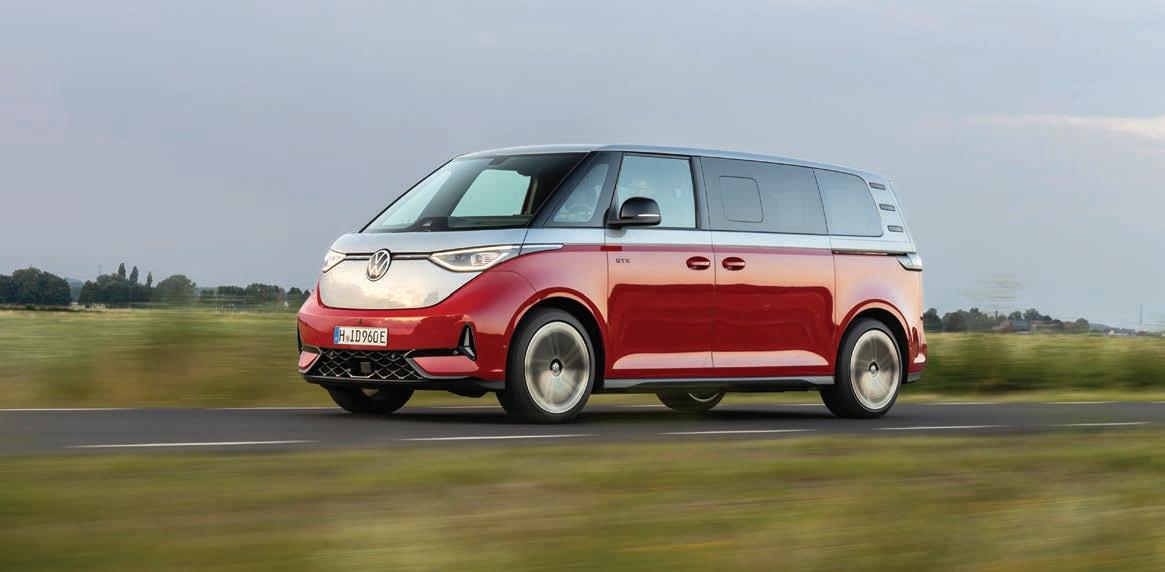
e top gun pick-up for some time has been the Isuzu D-Max. Andrew Walker explains why it’s been the CC&V award winner for three years in a row
e Isuzu D- Max has been our Pick-Up of the Year for three years in a row. Why?
Because it offers the most comprehensive range of single, extended and double cabs and conversions in the sector. Plus the latest Isuzu D-Max has undergone some cosmetic changes, including a freshly styled front grille, while the All-Purpose and Adventure models have also received new wheels.
Some body colours have changed as well. Dolomite White exclusive to the V-Cross replaces Pearl White, with Biarritz Blue replacing Sapphire Blue both on V-Cross and DL40. And inside, both the DL40 and V-Cross have been upgraded with newly designed leather upholstery, utilising horizontal layering for a more spacious feel.
Engine and performance
All versions are powered by the 1.9 litre


Specifying the automatic gearbox sees that rise slightly to 13 seconds.
Inside e D-Max cabin is more car-like than ever. e seats are hard wearing as well as

comfortable thanks to the six-way adjustable driver’s seat. Utility comes with a height and reachable adjustable steering wheel, steering wheel mounted audio and cruise controls, DAB radio, CD player, remember them, Bluetooth, a front USB port , 2 speakers and a 4.2” multi-information display.
Continued on page 38



Continued from page 37
e floors are vinyl covered, with under seat base storage, flat folding rear seats, height adjustable head rests and a front cup holders. e deep front and rear door pockets will hold a bottle each, and there’s a driver’s foot rest.
Outside
e DL40 comes with Bi-LED headlights, LED front fog lights, daytime running lights and rear lights, dark grey and chrome radiator grille, side steps and newly designed two-tone 18” alloy wheels.
DL40 specifics
e DL40 comes very well kitted out. ere’s a 7” multifunction colour touchscreen


that’s compatible with Apple CarPlay and Android Auto and has six speakers, keyless entry, a push button start, dual-zone climate control, bi-LED headlights, leather upholstery, two-tone 18” alloys, silver side steps, front and rear USB ports and an eight-way electrically adjustable driver’s seat. Safety features include front and rear parking sensors and a reversing camera.
All of the D-Max range comes with raft of safety features including Forward Collision Warning, Autonomous Emergency Braking, Forward Collision Warning, Traffic Sign Recognition, Intelligent Speed Limiter, Lane Departure Warning, a Blind Spot Monitor, Emergency Lane Keeping and Rear Cross
Traffic Alert. Isuzu’s SYSTEMS2 cruise control includes an adaptive function is also on DL40. Passengers will benefit from front, side, curtain and driver knee SRS Airbags and a centre SRS airbag.
Economy and emissions
e DL40 auto delivers 30.7 mpg and emissions of 241g/km. It’s fitted with a Selective Catalytic Reduction (SCR) system to reduce harmful Nitrogen Dioxide levels.
Every version has a payload rating of at least 1,070kg, which is important for commercial vehicle tax purpose. ere’s also a 3.5 tonnes towing capacity. Another interesting point is that all models weigh

under 2,040kg, so are subject to normal passenger car speed limits.
Off-road capability
It’s perfect for off-road use. e selectable shift-on-the-fly 4WD drive engages faster, rear axle articulation has increased and all models bar entry-level Utility models come with a mechanical rear diff lock.
On the road
Despite its size the D-Max is actually quite nimble, with the electronic steering making it easy to manoeuvre. It handles the road much more like a large SUV than the previous D-Max. It’s a little slow from the off, so give yourself a bit more time to pull out from a junction. e only time it feels like a pick-up is when you drive along narrow winding lanes where the size and weight show themselves. It feels impressively safe on a motorway run, and is surprisingly quiet and comfortable for what is a work vehicle, with noticeably less body-roll than on the last version. True, on tight roundabouts and in small parking spots, you’ll need to flex your arms a bit, but the reversing camera helps in tight spots.
Comfort
Excellent leg room all round and rear seat passengers praised teh ride, which is less bouncy unladen than on the previous model. All dashboard controls fall easily to hand


and the touchscreen is clear and concise. Connection to CarPlay was seamless.
Urban off-road
anks to a couple of empty farms located close to where we are based, we were able to venture slightly off-road alongside the River Bollin. e D-Max has a wading depth of 800mm, so the 500mm of flooded road we drove through after the recent heavy rain was easy to get through. A drive along a boggy gravel track and across a grass field were also dealt with comfortably as we utilised the 4WD. It will, of course, tackle a lot tougher terrain than that offered in north Cheshire.
When other pick-up manufacturers shied away from the sector, Isuzu is to be congratulated on sticking to its guns and
offering such a great amount of choice across a range of single, extended and double cab model’s and conversions. On the DL40 the suite of safety features including adaptive cruise control and a reversing camera is impressive. If you need to go off-road the DL40 will do that to.
Isuzu switched to a smaller 1.9 diesel unit when it launched the previous D-Max range, and it’s still here. It works fine in almost every situation, but it’s lack of out-and-out pull could be an issue if you’re towing a heavy load up a very steep hill. Inside, the cab has some cheaper plastics on the lower part of the dashboard, centre armrest and door pockets, but it’s solidly made nonetheless.
Offers a myriad of models to fit your budget, all with on-trend tech and safety. Does the things a pick-up is supposed to do, but with a refined touch. DL40 is a fine model if your pockets won’t stretch to the range-topper. e tweaks to the front and rear, internal trim and wheel options illustrate that Isuzu isn’t resting on its laurels, especially with the Ranger and Amarok back in town.
Still our favourite CC&V RATING: N N N N N

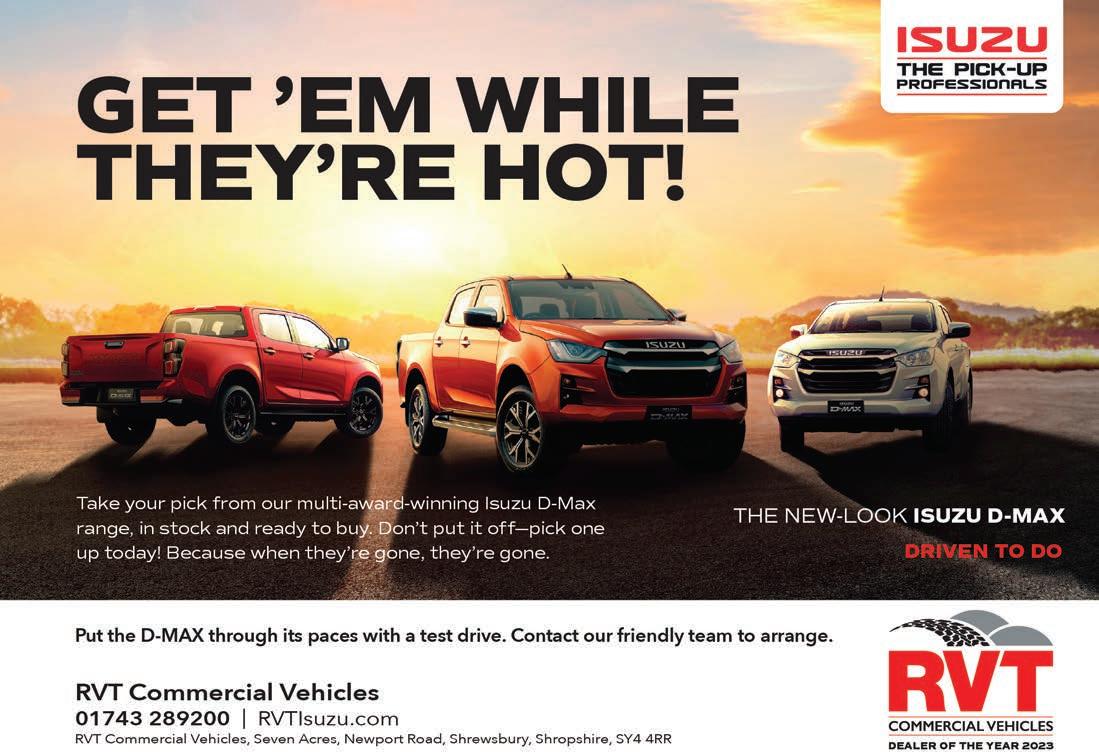


Chinese LCV brand Maxus was one of the stars of the 2024 CV Show, where its impressive stand showcased two new models, the MIFA 7 MPV and its small electric van, the eDELIVER 5. CC&V was the first publication to be invited down to test one, and we grabbed the opportunity with both hands. Here’s how we got on...
e eDELIVER 5 is a baby brother to larger electric siblings the eDELIVER 7 and eDELIVER 9. In size terms it’s reminiscent of the old Nissan e-NV200 and sits between the smaller electric offerings from Nissan, Renault and Mercedes and the larger eDELIVER 7, Ford E-Transit Custom, Vauxhall Vivaro electric and the Renault Trafic E-TECH.
Model choice and driving range
Two versions are offered: the L1 H1 and the L1 H2. Both are fitted with a 64kWh battery for a driving range of 208 miles combined WLTP or 300 miles urban driving.
Battery and power
Peak power is 120kW, with peak torque 240Nm. Both versions are FWD and comes with a top speed of 75mph.
DC Charging time 10-80% is 0.7 hours, with AC Charging from 5-100% taking 7.5 hours. e port is located on the front right hand sides of the van.
Both versions feature ahost of safety features, so brace yourself for a blizzard of acronyms.
ere’s FCW (Forward Collision Warning), AEB (Automatic Emergency Braking), ACC (Adaptive Cruise Control), LDW (Lane Departure Warning), LKA (Lane Keep Assist), ELK (Emergency Lane Keeping), SLIF (Speed Limit Information Function) and IHC (Intelligent High beam Control).
Also included are a tyre pressure monitoring system, ABS + EBD + ESC, front and side airbags for driver and front passengers, a 360 degree around-view system and a rear parking sensor. Phew!
Both versions come with a tool kit, rear trailer hitch Interface, a full size spare tyre, double sliding side door, rear double gate doors with 180 degrees hinges, a steel bulkhead, PVC and wood floor and four load floor binding rings.
ED5 comes well equipped, too. Electric
power windows, two speakers, 7” LCD instrument cluster, 12.3” infotainment screen, with MP5, USB, Bluetooth, wireless Apple CarPlay and Android Auto, DAB, a 12V socket, USB interface, smart keys and an excellent air con system.
We’re pleased to say that even on our pre-production test van, the 12.3” centre touchscreen was a real highlight, with clear graphics, fast responses and simple to understand inputs.
Connecting an iPhone to CarPlay was quick and seamless. ED5 also offers Internet of Vehicle (IOV) capabilities including SatNav and voice control with telematics as optional.
e van warranty is for five years/100,000 miles, with the battery pack covered for eight years/125,000 miles
MAXUS has created a very cute looking electric van. When we drove it into Liverpool city centre it garnered plenty of attention. Outside the Everyman eatre, the staff came out for a nosey and commented on its ‘Lego’ looks. A passer-by described it as a baby ID.Buzz Cargo and some university students loved the colour combo.
Continued on page 42
Established in 1948 by the Woodhouse and Barton families, Sandicliffe Motor Group is one of the most trusted and reliable car dealerships in the region. It still keeps their family ethos and echoes family values in everything they do. It was recently named one of the Sunday Times’ Best Places To Work.
Now spanning four locations across Nottingham, Leicester and Loughborough Sandicliffe represents a wide range of well-known automotive brands, including Ford, Ford Commercials, GWM ORA, INEOS, Mazda, Maxus and Nissan, as well as providing a large range of high quality used cars and vans. is diverse offering ensures that customers have access to an extensive selection of vehicles to meet their specific needs and preferences, assisted all the way by the dealer’s dedicated sales team, with its unwavering dedication to excellence.
But Sandicliffe don’t just deal in new and used vehicle sales. It also provides bespoke financing options, competitive trade-in prices for customers looking to upgrade their current vehicles, servicing and maintenance, parts and accessories, and MOT testing facilities. Sandicliffe also provides.

As a trusted partner of SAIC Maxus, Sandicliffe offers customers access to a diverse range of Maxus vehicles renowned for their durability, performance, and innovation. Whether you are in the market for a reliable commercial van or a versatile people carrier, Maxus vehicles combine cutting-edge technology with superior craftsmanship to deliver a driving experience that exceeds expectations.
e Sandicliffe Maxus showroom in Stapleford showcases the best of the brand, from the compact eDeliver 3 to the versatile Deliver9. Whether electric or diesel, Maxus have a van for to suit your needs.
Specialised sales staff and aftersales teams
Sandicliffe’s specialised sales staff have extensive product knowledge and a passion for delivering personalised service to every customer. ey are dedicated to helping you find the perfect vehicle that suits your needs and budget. Moreover, Sandicliffe’s dedicated aftersales teams provides customers with comprehensive support and maintenance services to ensure the longevity and performance of their vehicles.
From routine maintenance checks to complex repairs, Sandicliffe’s aftersales teams have the expertise and resources to keep your vehicle in optimal condition.
Whether you are looking for a new vehicle, schedule a service appointment, or explore financing options, Sandicliffe’s convenient locations across the Midlands ensure a seamless and hassle-free experience.
Contact Us:
For more on any of the brands Sandicliffe represents, contact us on 0115 939 5000, or through our website at Sandicliffe.co.uk.
For more on Maxus, contact us via andrew.phillips@sandicliffe.co.uk

Continued from page 40
Ostensibly, it looks very much like the smaller eDeliver 3 in shape. However, it features a narrow black band at the front with ‘C’ shaped LED daytime driving lights, the Maxus logo in the centre, and a lower down grille featuring twin circular spaces.
e rear is minimalist too, coming with three oval-shaped lights on the edge and centre of either side.
Inside
‘Stylish’ is the word that springs to mind in the cabin. In many ways it follows the exterior in that it’s very minimalist. You literally have the centre infotainment touchscreen located in the centre of the dashboard and low down to the left of the driver, the controls for the electric mirrors, lights, de-misters, electric parking brake and EV switch, and that’s it. e steering wheel houses the cruise control on the left and the phone, volume, voice control, level of brake regeneration and the driving mode controls on the right. e wiper stalks on the left and on the right you have the gear selector. It’s by far the least busy cabin we’ve ever sat in and all the better for it.
e overall quality of the seat fabrics, dash and door finishes and switchgear is pretty good. It’s all usefully black and grey and the rubber floor protectors will keep that area clean as well. None could be described as ‘soft-touch’, however.
Cabin practicality
Low down on the centre dash there’s a pull down twin cup holder, below which are twin USB ‘C’ inputs and a 12v socket. ere isn’t a glove box and only narrow netted storage on the doors which also feature the electric window and doors locked/unlocked switches and a flat door opening catch. You do get a cabin wide roof shelf and a drivers armrest.
e driver’s seat adjusts a bit but thanks to


“When we drove it into Liverpool city centre it garnered plenty of attention. Outside the Everyman eatre, the staff came out for a nosey and commented on its ‘Lego’ looks. A passer-by described it as a baby ID.Buzz Cargo, and some university students loved the colour combo.”

the full bulkhead won’t lean back much, a common issue with small vans. e twin front passenger seat offers good legroom for both but as with the driver’s seat, you can’t adjust the back as much as perhaps a taller driver would like.
If you drive in and out of an urban area, the ED5 is the easiest vehicle we’ve ever driven for that environment. When you climb in the engine starts automatically, select D and away you go.
Using the highest level of brake regeneration of three gives the van onepedal driving so you rarely need to use the brakes as the ED5 slows down for you. In Eco mode the battery power is reduced and in
maximum regen, the van moves quite slowly as it harnesses as much energy as possible. Reduce the regen level and move into Normal driving mode and it feels nimbler as more power is released. If you really want some dodgem car-style fun you can turn the regen off and select Sport mode, at which point the ED5 literally shoots ahead.
If you need to reverse, the inclusion of a really clear camera helps massively and the default start-up 360 degree steering function is also useful, giving you a view all around the van. is can be viewed in full-screen or picture-in-picture format, although in tight, city traffic it has a tendency to beep a lot. It clearly works – but we turned it off.
Access to the load bay is good, with sliding doors on either side. e lack of any centre gear stalk means the driver can access or exit the cab from the passenger side and the 60:40 rear doors open wide enough to get most things in. Only the wheel arches intrude into the load bay space.
If we’re going to complain about one thing, it’s the ride quality. A combination of the battery weight, slim tyres and seat thickness do contribute to a rather firm ride.
Continued on page 44

Continued from page 42
To be fair to Maxus, it’s a problem which almost all EVs, and many plug-ins, share, so don’t expect a magic carpet French ride, especially over the current road surfaces across the UK.
Pros
Looks-wise it’s a head turner. Anyone driving it will smile, a lot, as it’s just so easy and relaxing to pilot.
e minimalist dashboard and vehicle controls are a winner. e load space and ease of access to these is very good.
Cons
e ride is a little firm. Cabin storage could be improved, and it has to be said that both versions don’t come cheap.
Conclusion
To see just how far Maxus has come in the design of its vans in just the past few years should send warning signs to all other van manufacturers. e Chinese manufacturer now offers four electric vans and an electric pick-up. Who else can say that?
If we go back and look at the first of these, the eDeliver 3, it now does feel dated inside. But the large eDeliver 9 still looks good and the mid-sized eDeliver 7 was only launched in January, so it too feels fresh and new. Bettering them all, at least as far as we’re


concerned, is the eDeliver 5. It’s an evolution of all that went before. Just be aware of the firm ride and lack of seat angle adjustment. And, with it costing from £34,000, we’d look to lease one as it’s not cheap.

DIMENSIONS
L1 H1 – Externally:
L: 4,800 x W: 1,874 x H: 1,960 mm. Internally
L: 2,654 x W: 1,704 x H: 1,455 mm.

Almost too good-looking to be a commercial vehicle. Shares a look of the cute ID.Buzz, which is no bad thing, and is a huge leap forward on Maxus’s new vehicles from 12 months ago. A Lego kit in the making CC&V RATING: N N N N N
L1 H2 is the same length and width but higher at 2180mm, making the internal roof space 1,675mm.
Cargo volume for the L1 H1 is 6.6m3, for the L1 H2 7.6m3 Payload capacity is 1,200kg.

On Wednesday, 1st May, Euro Maxus in Cardiff hosted a launch event to provide customers with their first look at the new vehicles, including the groundbreaking ED5. is model has gained attention for its innovative features, environmental credentials, and the promise to redefine expectations for what a van can offer.
Euro Commercials, a well-established commercial vehicle dealership, has over 40 years of experience providing outstanding service to both local and national businesses. ey were thrilled to introduce the Maxus brand and are dedicated to offering expert advice to match their customers’ business requirements. Furthermore, their on-site aftersales team is available to assist
customers throughout their vehicle’s lifespan, with highly skilled technicians who possess in-depth knowledge of the Maxus product.
e opening of Euro Maxus marks a significant milestone for the company and reinforces its commitment to van operators in the South Wales area. e new showroom offers new and used vehicles that are specifically designed to deliver efficient, reliable, and cost-effective transport solutions. With a strong focus on quality service and reliability, they strive to build long-lasting relationships with their clients.
e introduction of the Maxus brand is a testament to their dedication to staying at the forefront of the commercial vehicle industry.


Stephen Paul and Daniel Kuck are looking forward to selling the Maxus range

Euro Maxus takes pride in their commitment to customer satisfaction. Whether you are a local business looking to expand or a national corporation in need of a reliable fleet, Euro Maxus is ready to provide tailored solutions to meet your specific needs. Trust in Euro Maxus for all your commercial vehicle needs, where expertise meets excellence.
eir knowledgeable and passionate team are on hand to guide customers through the features and benefits of each model, helping them to find the vehicle that best suits their needs. allowing customers to make informed decisions with confidence.
Located at Ipswich Road, Cardiff, CF239AQ, the new showroom is ready to welcome new customers.

ere’s an all-new eSprinter and Company Car & Van was lucky enough to drive one recently. It comes with almost three times the driving range of the Mk1 eSprinter plus a number of other improvements. Here’s what we found out.
What’s new ?
With the addition of a 113kWh battery the eSprinter range is now as high as 271 miles. And there’s also another version powered by an 81kWh battery that’s good for 185 miles. ere’s also a new brake regeneration system with an ‘auto’ mode and an updated MBUX infotainment system.
Model choice
e original eSprinter came in one spec, Progressive, and one size, L2 H2. With eSprinter Mk 2, as well as two batteries, there are also two vehicle choices panel van and chassis, two trim levels, PRO or SELECT, two vehicle lengths, L2 and L3, and two motors, 100kW or 150kW, so there’s clearly been an evolution.
e entry level PRO comes with plenty of driver-friendly features including, the MBUX multimedia system with 10.25” touchscreen, DAB, Bluetooth, electric parking brake, air-con, a heated driver’s seat with armrest, a multifunction steering wheel and a double passenger seat.
From a practical point of view there are double side-opening doors to 270 degrees, a full head bulkhead, loading bay wall lining, a wooden floor and a towing eye rear. Safety features include ASSIST systems for Active Brake Attention, Crosswind, Blind Spot ASSIST, Intelligent Speed and Active Lane Keeping – which I’m pleased to say you can turn off from the steering wheel.
Infotainment
e previous eSprinter was rather sparse in this area so it’s refreshing to see that the latest version runs the updated MBUX system, which includes the 10.25” touchscreen, radio, Bluetooth and a multi-media interface with 3X USB C ports. With the £45 Smartphone Integration Package you also get wireless connected Apps for Apple CarPlay or Android Auto, an extra well with considering.
Charging
Charging speeds have improved, with 11kW AC charging and 115kW DC charging offered. Charging times for the 113kWh model are from 0-100% in 11 hours on an 11kWh wall box, with DC charging from 10-80% in just 42 min at the maximum 115kW charging speed. For the smaller 81kWh battery version, these times are


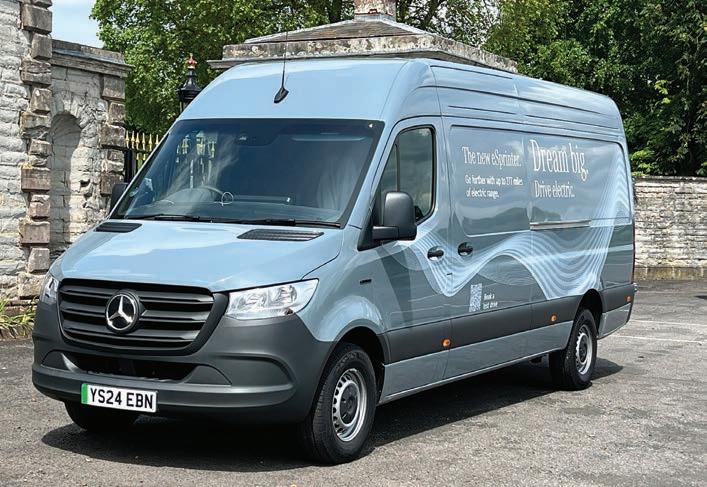
reduced to 8 hours and 32 minutes respectively, with home charging on a 7.4kWh charger taking 12.3 hours.
Driving modes and brake recuperation
Normal, Eco and Max Range are your options for driving mode. Normal mode replicates normal driving conditions, so there’s no brake regen offered and you use the battery up faster. You can remove this mode when you order your vehicle, leaving just Eco and Max Range for improved electric performance.
Utilising the paddles behind the steering wheel, the driver can also select from four regeneration levels. D- offers the most regen with maximum recuperation and fastest deceleration, through D or D+, which both reduce the braking force.
No big changes on the current Sprinter range, and unmistakably a Benz. Neat and tidy interior design with a clutter-free dash. All in all it’s our favourite large van interior and a very car-like cabin to be in.
A big, heavy battery, equals payload issues. Mercedes has classified all of the 115kWh versions with a 4.25 tonne GVW and one 81kWh model the 420 van L3 Pro as well. e smaller 81kWh battery versions come with either a 3.5 tonne or 4.15 tonne GVW.
Driving
e L3 model we drove is a long van, but in many ways doesn’t feel it. e electrically assisted steering is a major plus, with urban


driving made super-easy thanks to its well weighted feel and with little feedback it’s also a winner in a straight line making lightweight of longer motorway trips.
Performance and driving range
e L3 Select 414 panel van tested comes with 204hp and 400Nm from its 150KW E-motor and offers a 270-mile WLTP combined driving range. We drove 75 miles and used only 62 miles of range by taking advantage of the on-board brake regen. It is a reassuringly accurate driving range.
Pros
Massively improved battery range. Lovely comfortable ride and cabin. Packed with safety features and the latest connectivity. Plenty of model options inclusion chassis.
Cons
For anyone who passed their driving test after 1997, the largest battery version can’t be driven on a normal licence. Compromised payload for some. Largest versions are expensive.
CC&V VERDICT
Huge improvement on range makes this a go-to model. Careful of the licence issue on the bigger L3 model: younger drivers will need a Cat B licence to drive one, because of the weight. However, not all operators need a bigger payload and the smaller 81kWh version solves that problem. Expensive, but brilliant for all that.
CC&V RATING: N N N N N


Sytner London Corporate returns to commercial vehicle sales arena with new Mercedes-Benz vans
After an eight-year hiatus, Sytner Mercedes-Benz London Corporate is making a triumphant return to the commercial vehicle sales sector, bringing fresh energy and a renewed focus on excellence.
e company has assembled a dedicated team of experts to cater specifically to Fleet and Business customers, ensuring their diverse requirements are met with the highest standards of service and professionalism.
A new era of service and support e core of London Corporate’s comeback is its commitment to providing unparalleled support to its clients. e newly formed team comprises seasoned professionals with extensive experience in fleet and commercial vehicle sales. is team is equipped to offer bespoke solutions that align with the unique needs of each business, enhancing operational efficiency and productivity.
“We understand the complexities and demands of managing a fleet,” says Jo Corbett, Corporate Sales Manager at London Corporate. “Our goal is to offer our clients not just vehicles, but comprehensive support that includes financing options, maintenance packages, and personalized consultancy services.”
A diverse range of vehicles
London Corporate’s return is marked by a renewed partnership with Mercedes-Benz Vans, a brand synonymous with innovation, reliability, and luxury. e new model line-up includes a variety of diesel and electric vans and chassis cabs designed to meet the evolving demands of modern businesses.
“As the world moves towards sustainable solutions, Mercedes-Benz’s
electric vans
represent the future of CVs...”
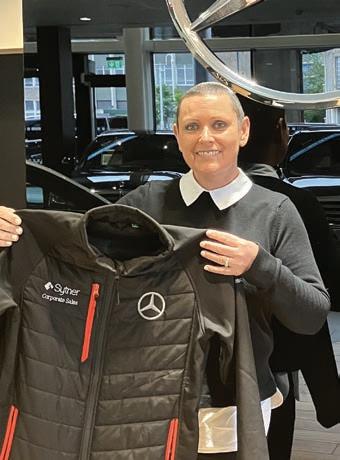
Diesel Vans: Known for their durability and fuel efficiency, Mercedes-Benz diesel vans continue to be a reliable choice for many businesses. e range includes models that cater to different load capacities and operational needs, ensuring there’s a perfect fit for every requirement.
Electric Vans: As the world moves towards sustainable solutions, Mercedes-Benz’s electric vans represent the future of commercial vehicles. ese vans offer zero emissions, lower running costs, and advanced technology features, making them an ideal choice for environmentally conscious businesses.
Embracing sustainability
e inclusion of electric vans in London Corporate’s portfolio is a significant step towards promoting sustainable business practices. By offering a range of electric vehicles, the company is helping businesses reduce their carbon footprint while also benefiting from the cost savings associated

with electric vehicle operation.
“We are proud to support our clients in their journey towards greener operations by providing cutting-edge electric vans from Mercedes-Benz” explains Stephen Hanifan, Head of Business.
Meet the sales team: Tracey Stewart
London Corporate is thrilled to announce the appointment of Tracey Stewart as the new Corporate Account Manager for Light Commercial Vehicles (LCV). Tracey brings a wealth of experience and a passion for excellence to her role, ensuring that our Fleet and Business customers receive unparalleled support and service.
Tracey joins with 12 years of experience in the motor industry, including 7.5 years dedicated to commercial vehicles. She became part of the Mercedes-Benz family in 2017, after previously serving as a fleet and commercial sales specialist for a renowned French manufacturer. Her decision to represent Mercedes-Benz stems from a deep appreciation for the brand - “I wanted to represent a brand and product synonymous with reliability and longevity, which is Mercedes-Benz,” Tracey says.
A passionate paddleboarder and skier, Tracey’s early career in risk management and customer service has honed her solutiondriven and problem-solving skills. Her approach to account management is centred on finding solutions that ensure the success of her customers’ businesses. “It’s about supporting the customer with the right tools for the job: the vehicle model/specification, funding platform, conversions, charging infrastructure, accessories, and more,” Tracey explains. “ e enjoyment for me is identifying the requirement, providing options, and then supporting the customer throughout the ownership of their vehicle,” .
Her dedication to delivering outstanding service and ability to secure new customers is evident in her achievements, including winning Sytner’s coveted ‘Managing Director’s Award for Customer Dedication’. Her perseverance and commitment to her role have remained steadfast despite facing a life-changing illness.
Sytner Mercedes-Benz London Corporate Sales takes pride in more than simply supplying aspirational cars and vans.
With national coverage, years of experience, an extensive customer portfolio, and strong leasing company relationships, our dedicated team is committed to providing exceptional service and support. We believe that our customers’ success is our success, and the appointment of Tracey is a testament to our dedication to this principle. Find out more, via mbvans@sytner.co.uk

Ford’s E-Transit Custom joins a family that can proudly boast being Britain’s best-selling vehicle. Here’s what we found when we tested the new electric model in Frankfurt recently.
e E-Transit Custom shares the majority of its DNA with the ICE version. ere are subtle exterior differences, namely no exhaust pipes, ‘E’ badging and the charging port. Step inside and again it’s very reminiscent of the combustion version. What is different is the powertrain.
ere are three powertrains, each based on the 65kWh battery pack, and four specs, Trend, Limited, Sport and MS-RT. Trend and Limited feature a 100kw motor with 130PS, the Sport a 160kw motor with 218PS and range topping MS-RT which comes with a 210kw motor and 285PS.
e E-Transit Custom can be ordered as a panel van, a double-cab with six seats, a Kombi with up to eight seats or a Multicab with a two-seat second row and L-shaped bulkhead. ere’s also two wheelbases, standard L1 or extended L2 but only one body height.
Interior
e E-Transit Custom dashboard features the same twin-screen setup as the combustion models. So a combination of the 13” SYNC 4 touchscreen infotainment screen and 8” digital information screen which sits in front of the driver. e electric handbrake is located between the centre air-vents and the gear selector is on the right steering wheel stalk, freeing up floor space meaning drivers can move across the cab for pavement exit and entry. And if there are three in the cab, there’s decent legroom for the centre passenger.
Quality is very good throughout and the seat fabrics, dash plastics and door finishes all cut the mustard.
Infotainment and switchgear
SYNC 4 is really easy to work and the touchscreen inputs and menus are both fast enough and clearly recognised. Apple CarPlay, Android Auto and a 5G Embedded Modem are included as standard.
We did connect an iPhone via a USB cable and it connected to CarPlay promptly. While we prefer to use Waze or Apple Maps, the built in Ford Nav is pretty good especially when compared to most rivals.
Cabin practicality
e gear selector is a simple steering column stalk, while the electronic parking brake switch is located between the centre air vents. is means there’s no floormounted controls whatsoever, which makes it far easier to move around the cabin.


Up front there’s two USB inputs and a 12v socket in the centre dash and a clever pull down cup holder. e doors feature three different storage spaces, with two dash top open areas as well.
Practicality
e E-Transit can carry up to 1,011kg and introduces a class-leading 2,300kg towing ability. It’s also fitted with a lower step-in height and load floor with independent rear suspension to improve handling and traction.
Battery range
Claimed maximum range is 209 miles on the WLTP combined cycle. With 125kW DC rapid charging, a 10-80% charge will take just 40 minutes. Plug-In at home on a 7.4kWh wall box and the same charge will take 8.5 hours.
Load space and practicality
e short wheelbase L1 offers 5.8 cubic metres of space increasing to 6.8 cubic metres for the extended L2. e rear doors open up to 90 or 180-degrees with a 1,400mm wide opening. Trend offers a 1,088kg payload, Limited 1,066kg, Sport 1,054kg, while the top-spec MS-RT 1,036kg. In comparison, the diesel Custom offers from 1,384kg – 891kg of payload capacity. All versions offer a braked towing capacity of 2,300kg.
Driving
It drives exceptionally well. We had a small payload on our test Sport model and this plus the van’s battery weight helped it stick to the road like glue. Even on some poor German road surfaces- yes ,there were some - it

takes bumps and imperfections with aplomb and the ride is very good. Light power steering makes urban driving easy and with the electric rear view mirror and reversing camera, parking was a cinch.
On the motorway the Custom cruises nicely. e electric motor can be heard at start up and when you slow down, but with anything playing on the speakers it too is barely noticeable.
Prices and savings
Trend trim is the cheapest, at £44,900. Limited costs £47,400, Sport £50,940 and MS-RT an eye watering £62,710, all + VAT so all are more expensive than a diesel Custom.
Pros
Looks, feels and drives very much like an ICE Transit Custom. Plenty of power and model choices. Excellent standard equipment.
Cons
Others offer a slightly longer range. Expensive at first glance. e heavy battery has a lower payload than some ICE versions.
CC&V VERDICT
Ford has worked hard to replicate the success of its ICE Transit Custom with the electric version. Drives and handles better then the diesel Custom and a 209-mile range is impressive too. Payload is pretty good as well. More expensive than a diesel but most operators will make this electric van work for them. A roaring succcess.
CC&V RATING: N N N N N


